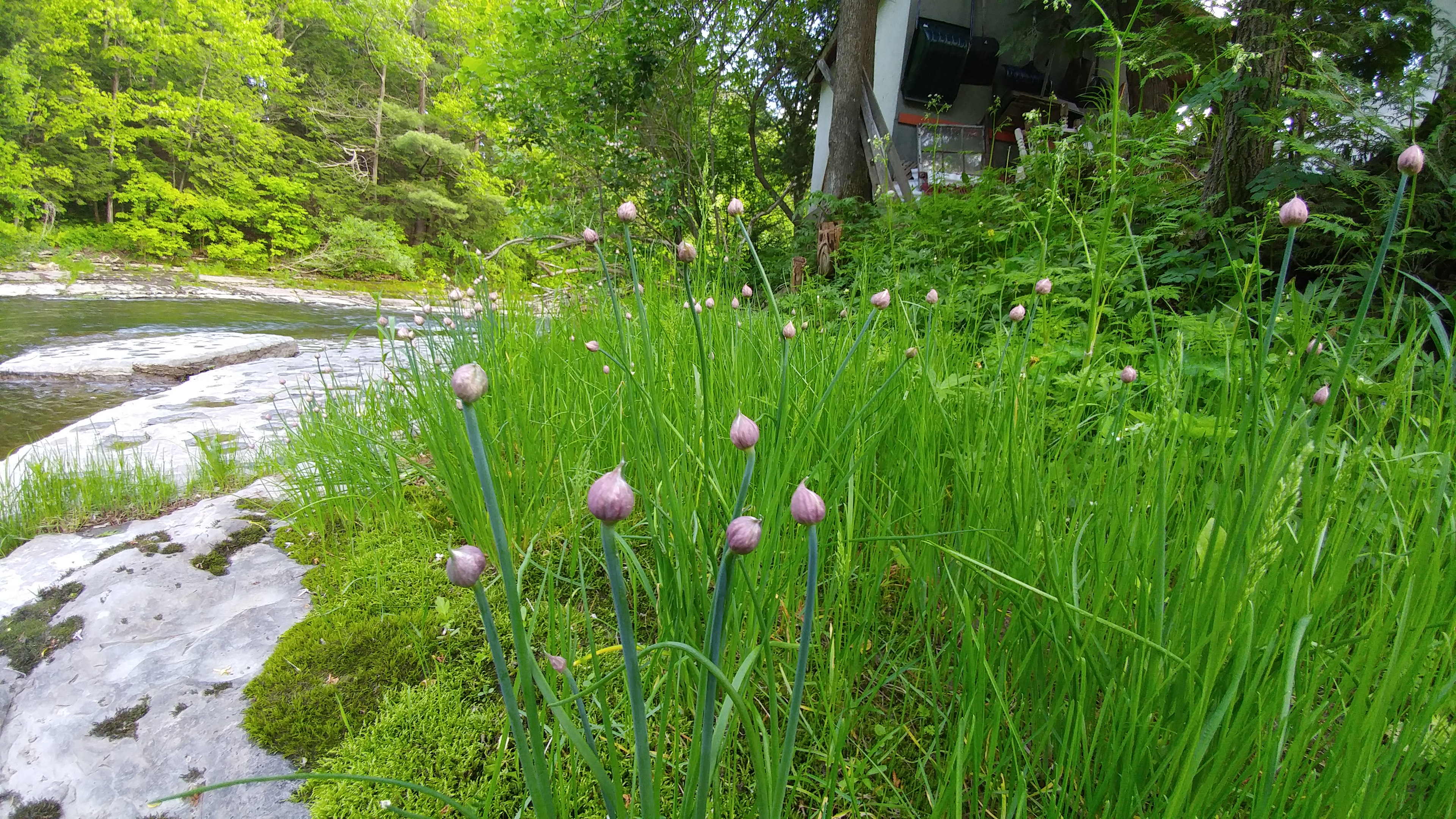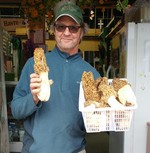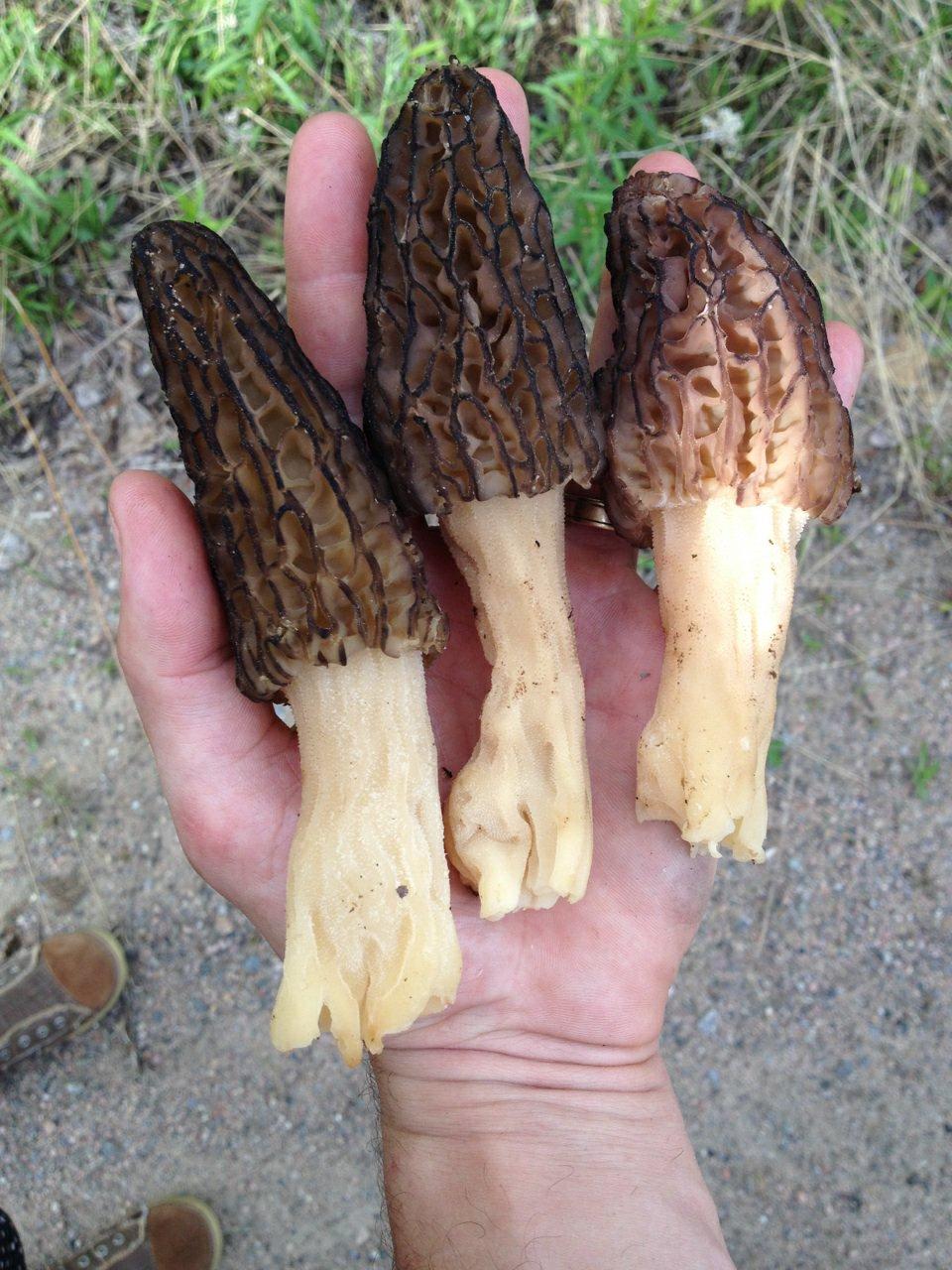Entries in 2017 (6)
Fall Mushrooms and Puffballs
Finally, the local wild mushrooms are out in full force!
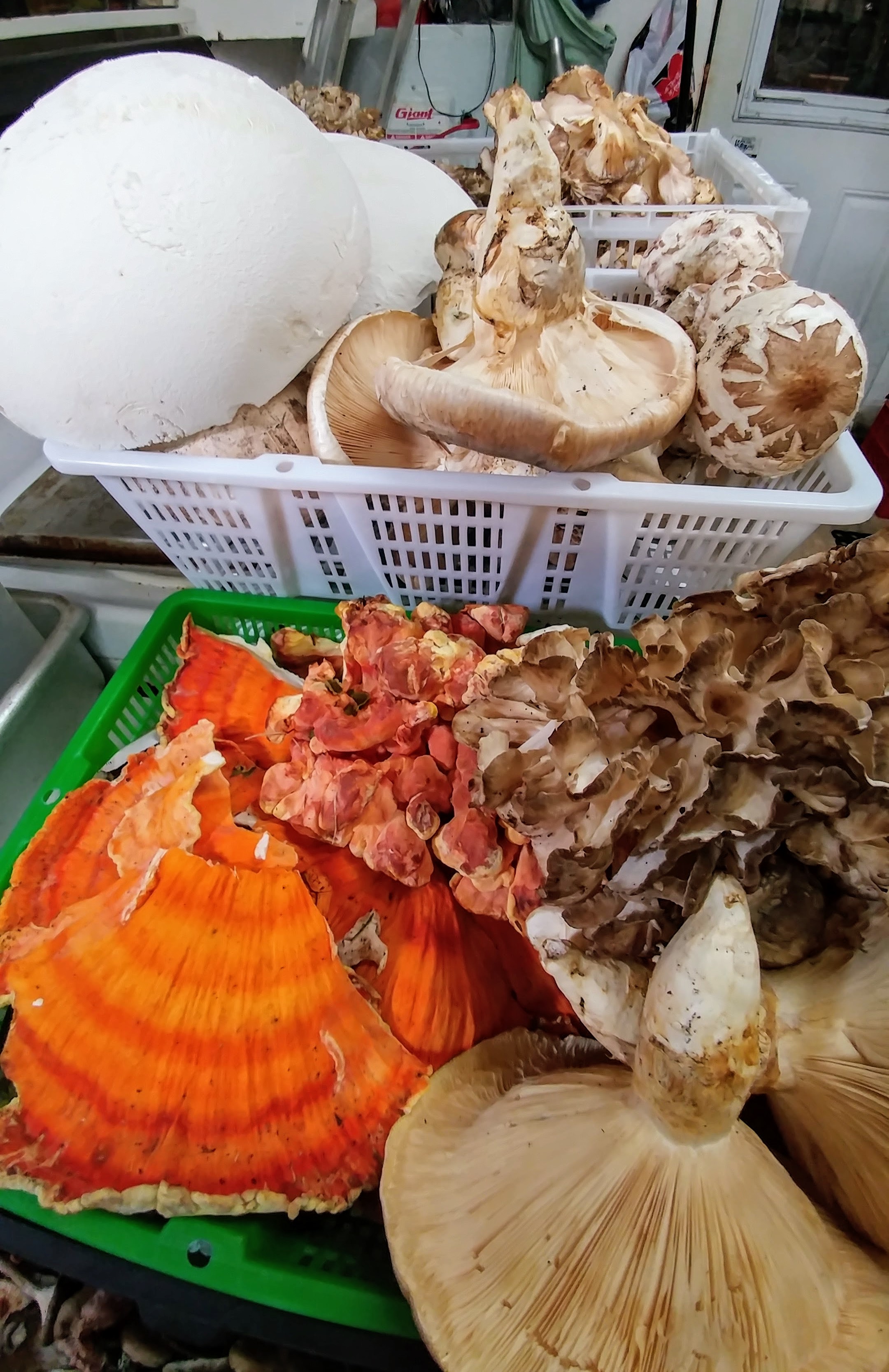 An autumn day harvest
An autumn day harvest 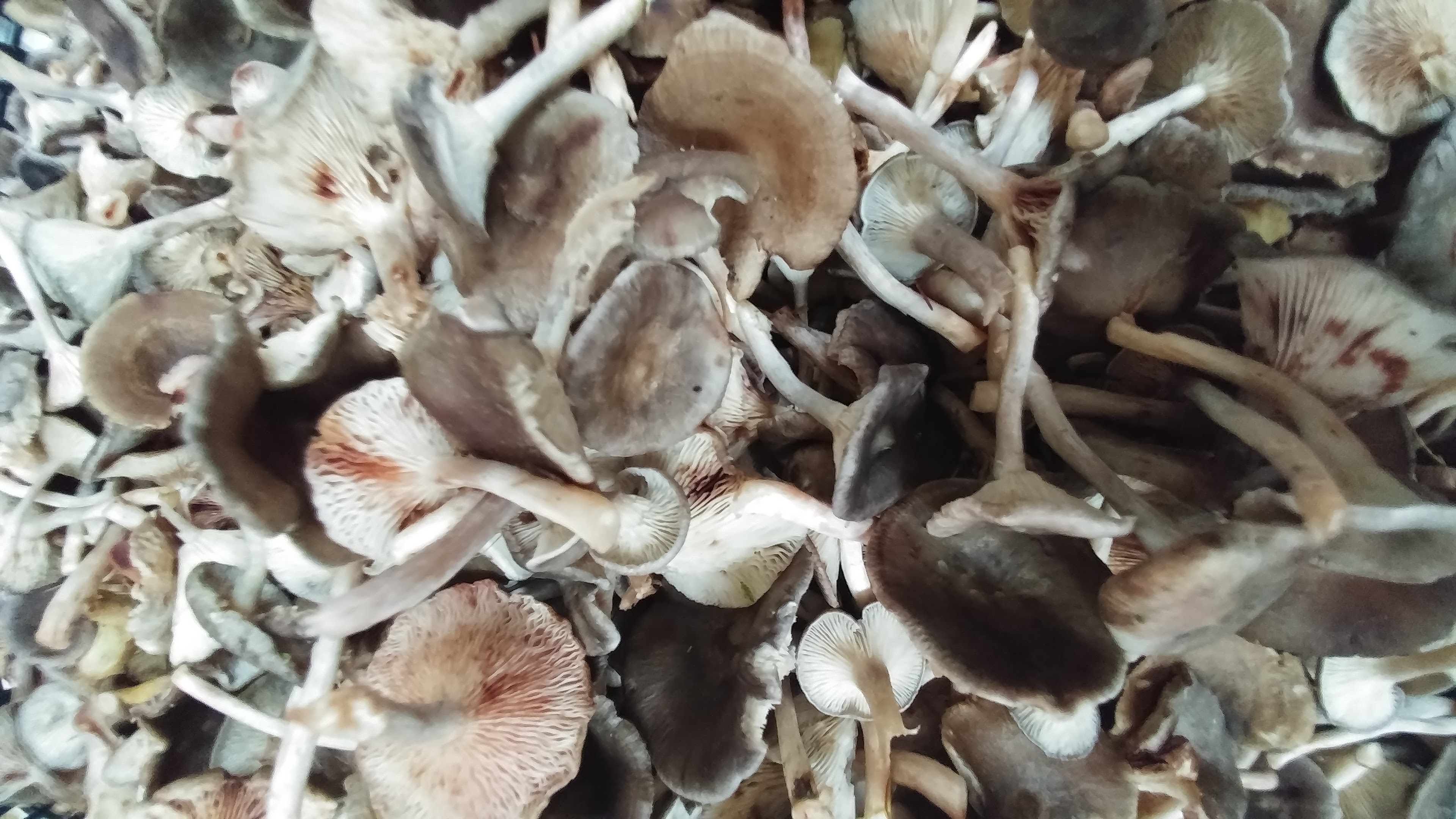 graylings - a rare treat in the chanterelle family
graylings - a rare treat in the chanterelle family
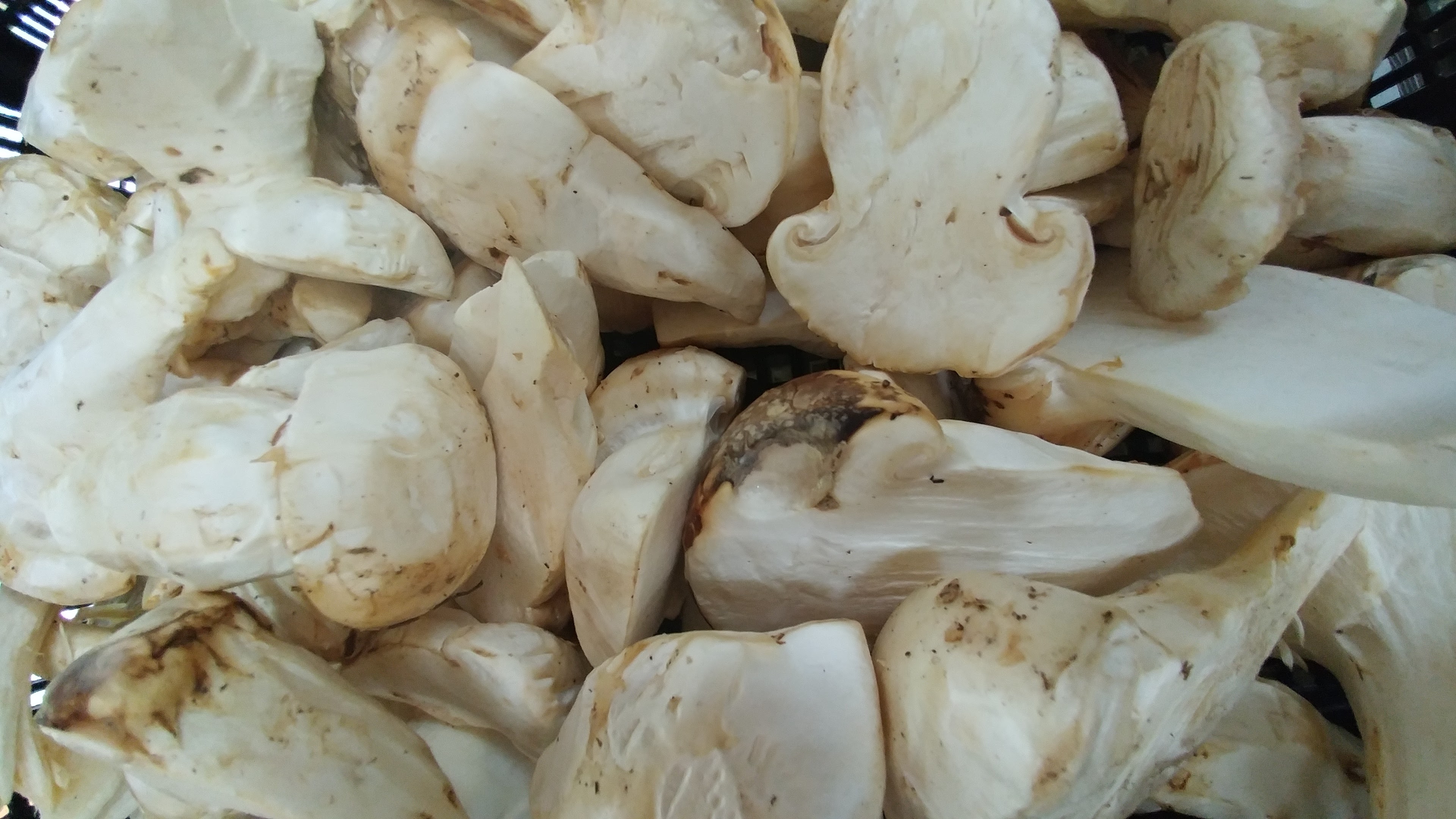 Armillaire pesant; Swollen Stalked Cat
Armillaire pesant; Swollen Stalked Cat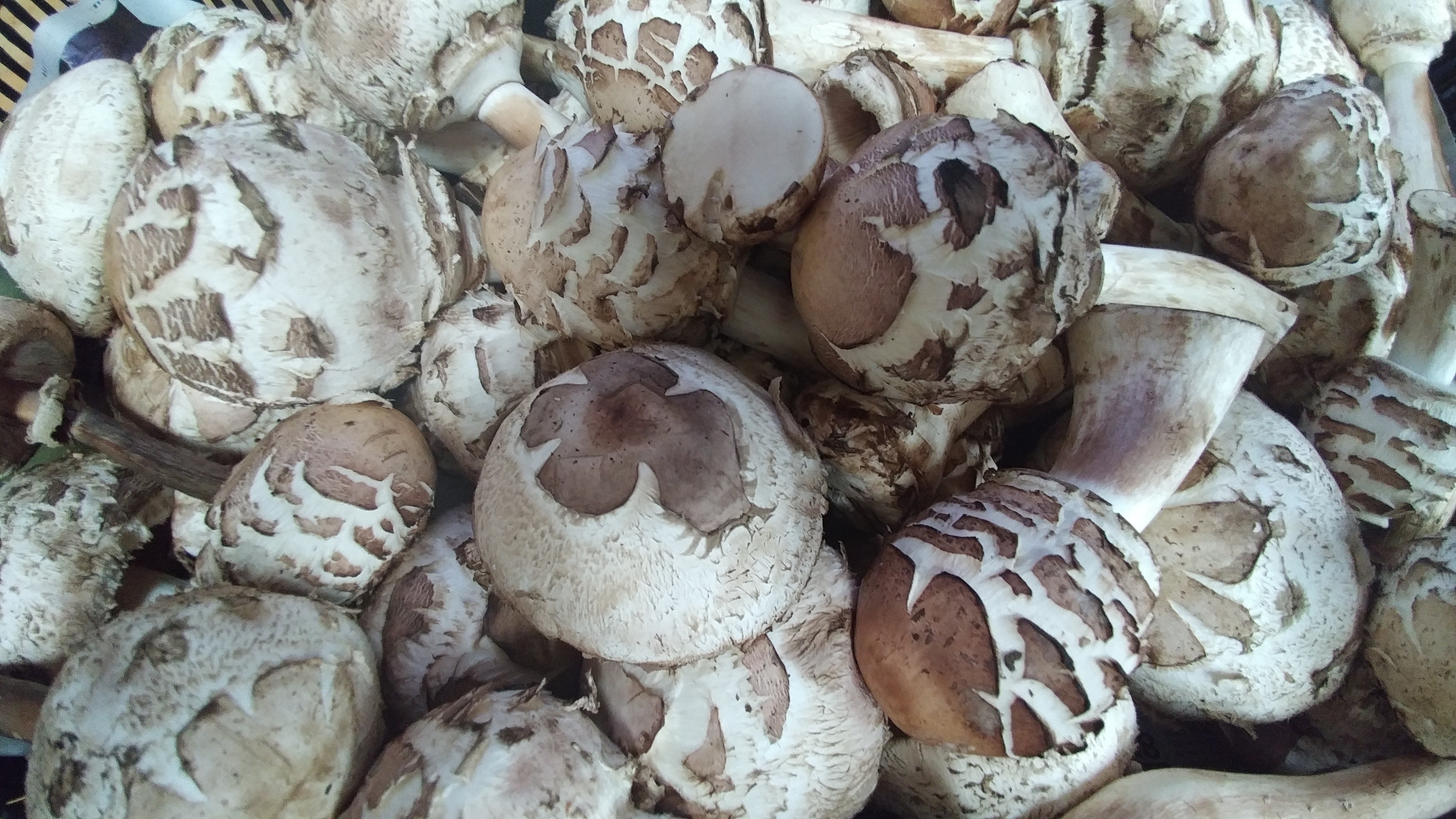 Parasol
Parasol
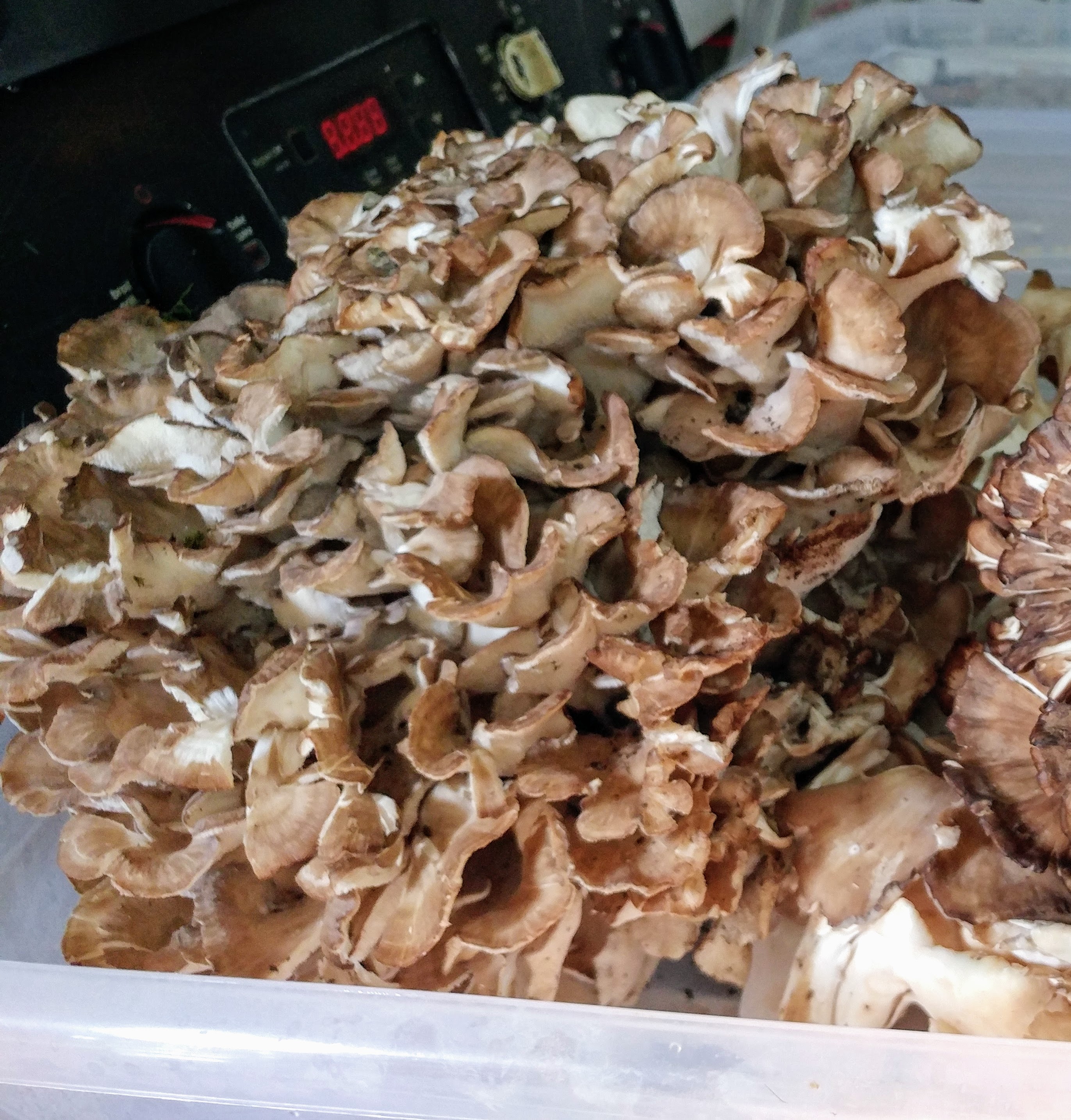 Hen of the Woods
Hen of the Woods
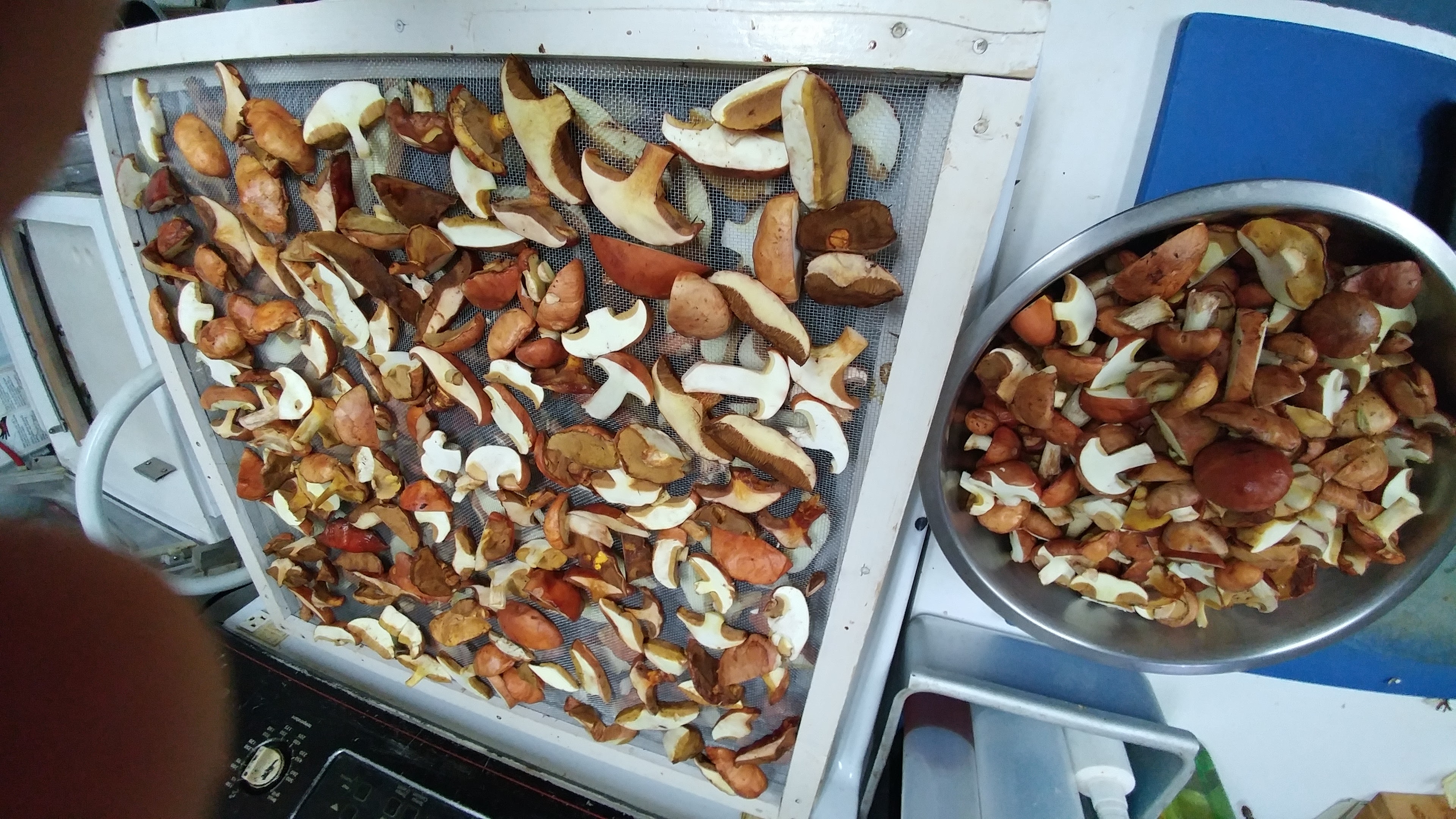 Slippery Jack - a yellow bolete that is especially good dehydrated.
Slippery Jack - a yellow bolete that is especially good dehydrated.
 Poule des bois/Hen of the Woods haul
Poule des bois/Hen of the Woods haul
Besides the Hen of the Woods (our favourite), the most spectacular is always the giant puffball, in season now.
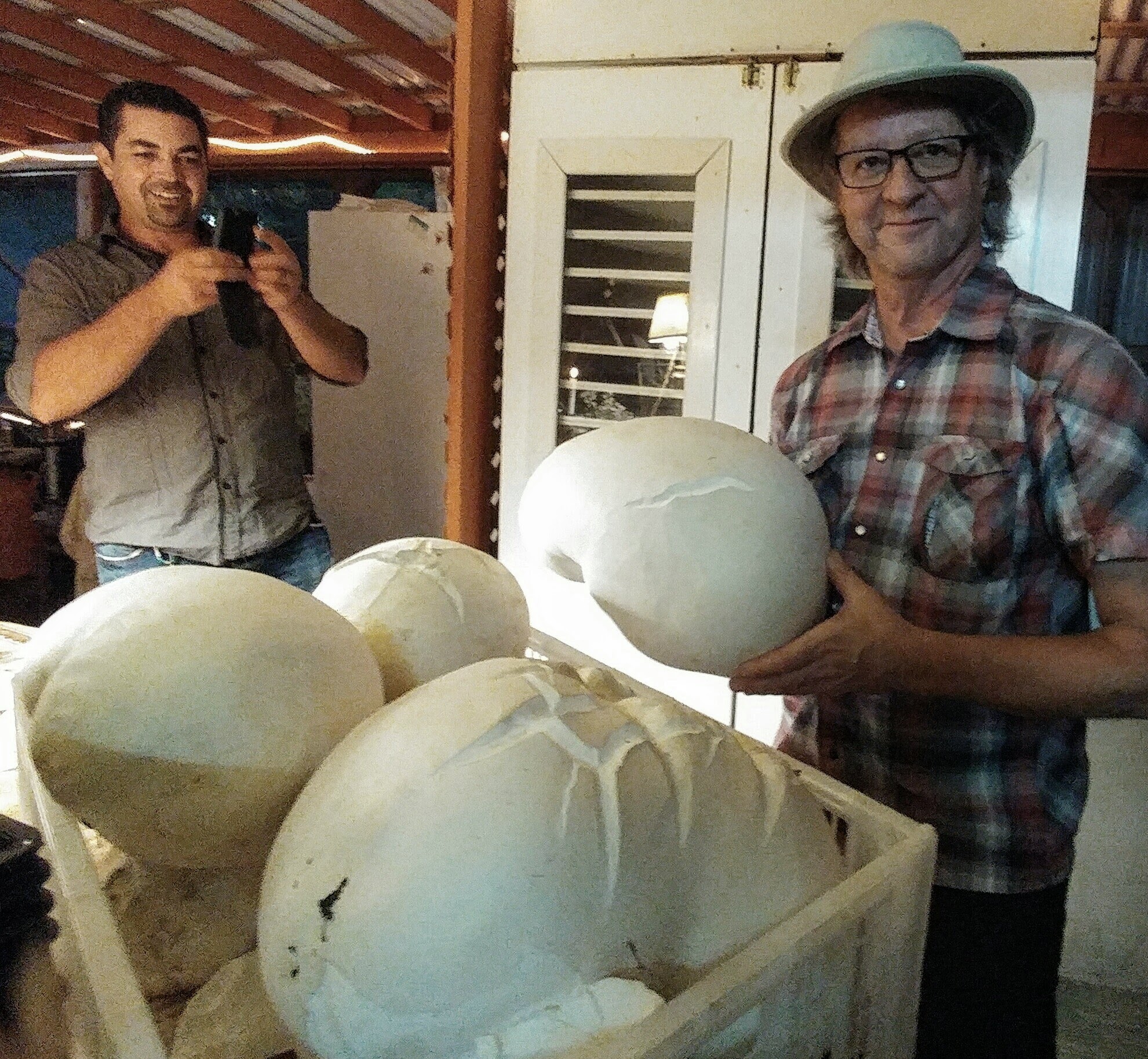
I have had multiple inquiries on how to cook it.
So, here’s the deal. It is easy enough to identify; if it is still firm and pristine white throughout when you slice it, it is good to eat. They go yellow and soft (not to mention) pungent smelling as they age past their prime.
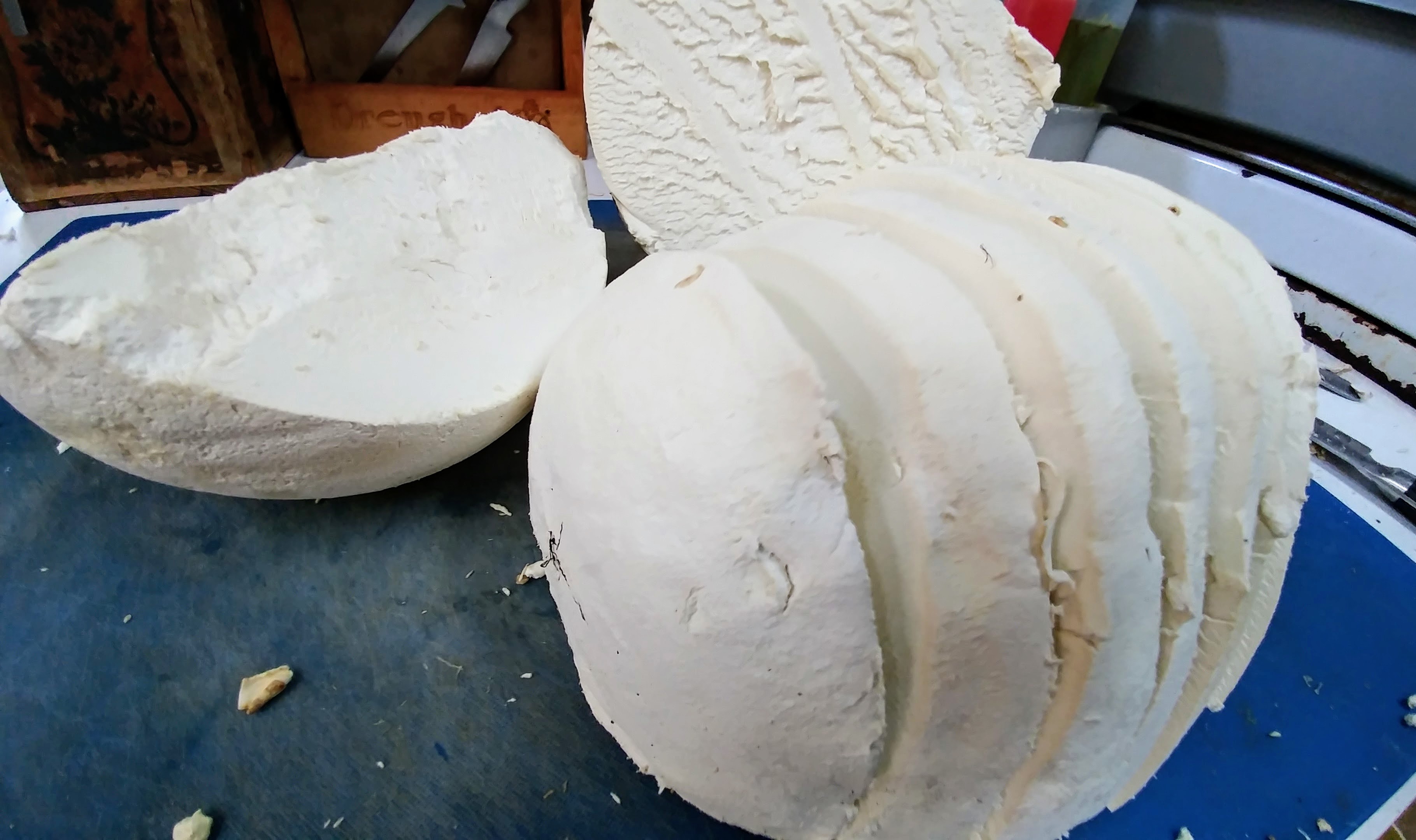
The best way to cook a giant puffball:
Peel and slice. Pan-fry or bake on parchment with a good amount of fat (I start with oil and finish with butter), flipping half way through. You want to gently brown it, on medium heat as opposed to high.
With its sponge-like texture, I find that it cooks up quite like eggplant. Best eaten straight out of the pan, it gets soft and loses volume as it sits, although it will taste good no matter.
It has a strong (ish) mushroom flavour, so I like to layer it with other flavours like tomato, cheese or root vegetables in a lasagne or gratin for example. It makes good soup too. You could dice it up and make spaghetti sauce, the options are endless.
It's not all about the puffball, especially with Matsutake season starting. I'm busy putting up the fall boletes for our dried mixes and butter etc, as well as yellowfoot chanterelles and hedgehogs, hundreds of pounds a week. We are still waiting on the autumn oysters and another half dozen varieties to complete my upcoming annual mushroom fest menu.. http://soupnancy.squarespace.com/wild-mushroom-event-october/
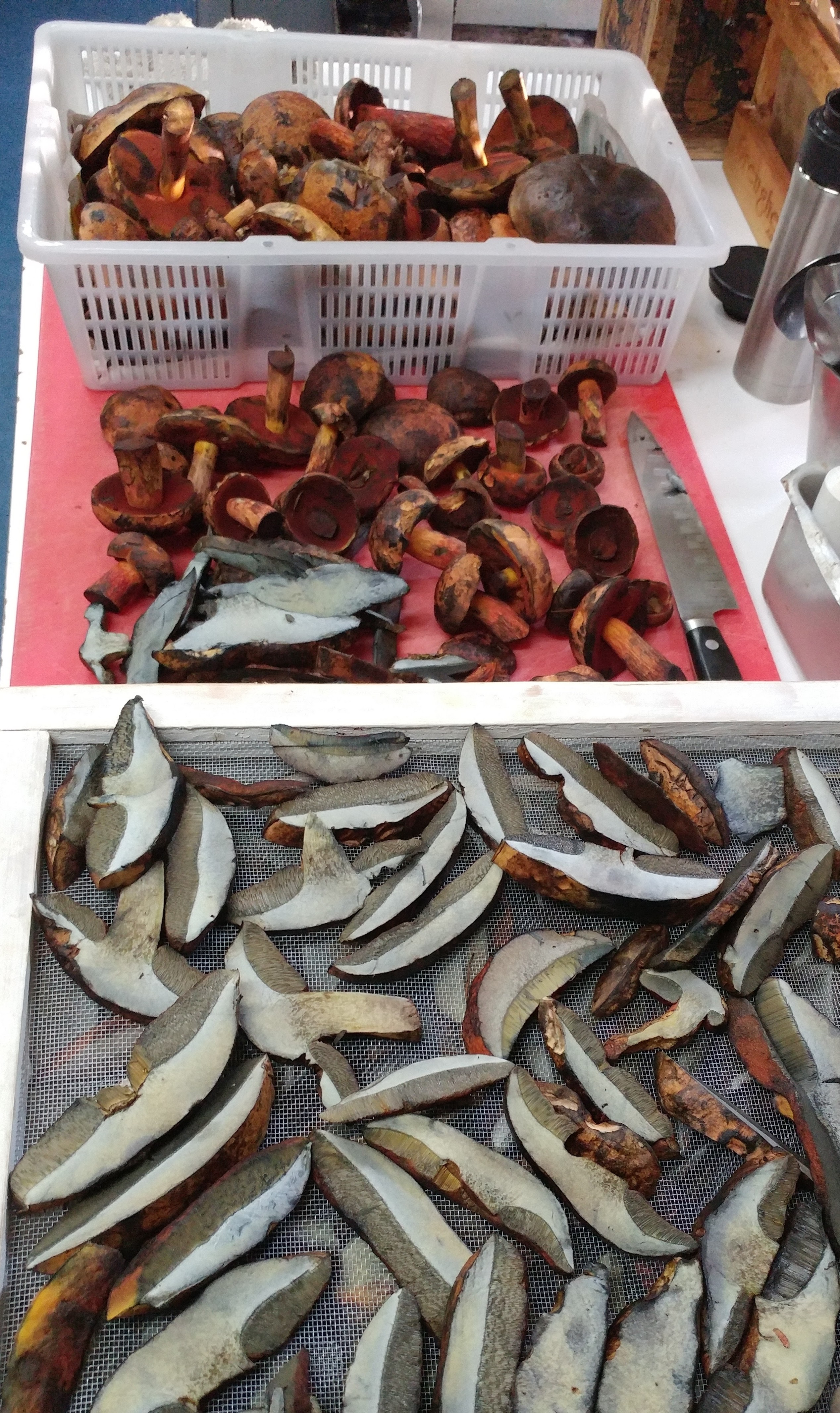
Red Mouthed Bolete, a dessert fave
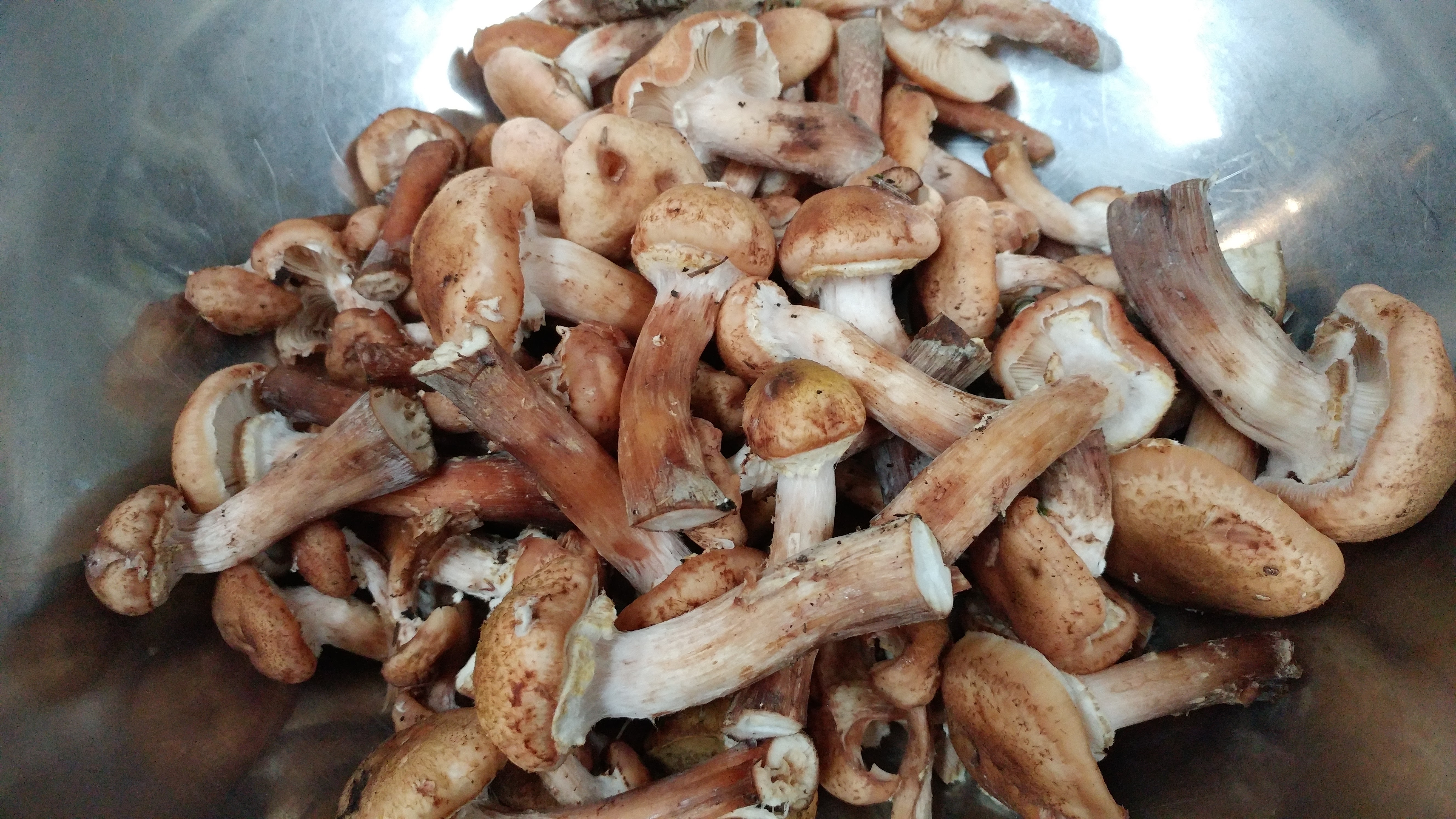 Armillaires Couleur de Miel; Wild Honey Mushroom
Armillaires Couleur de Miel; Wild Honey Mushroom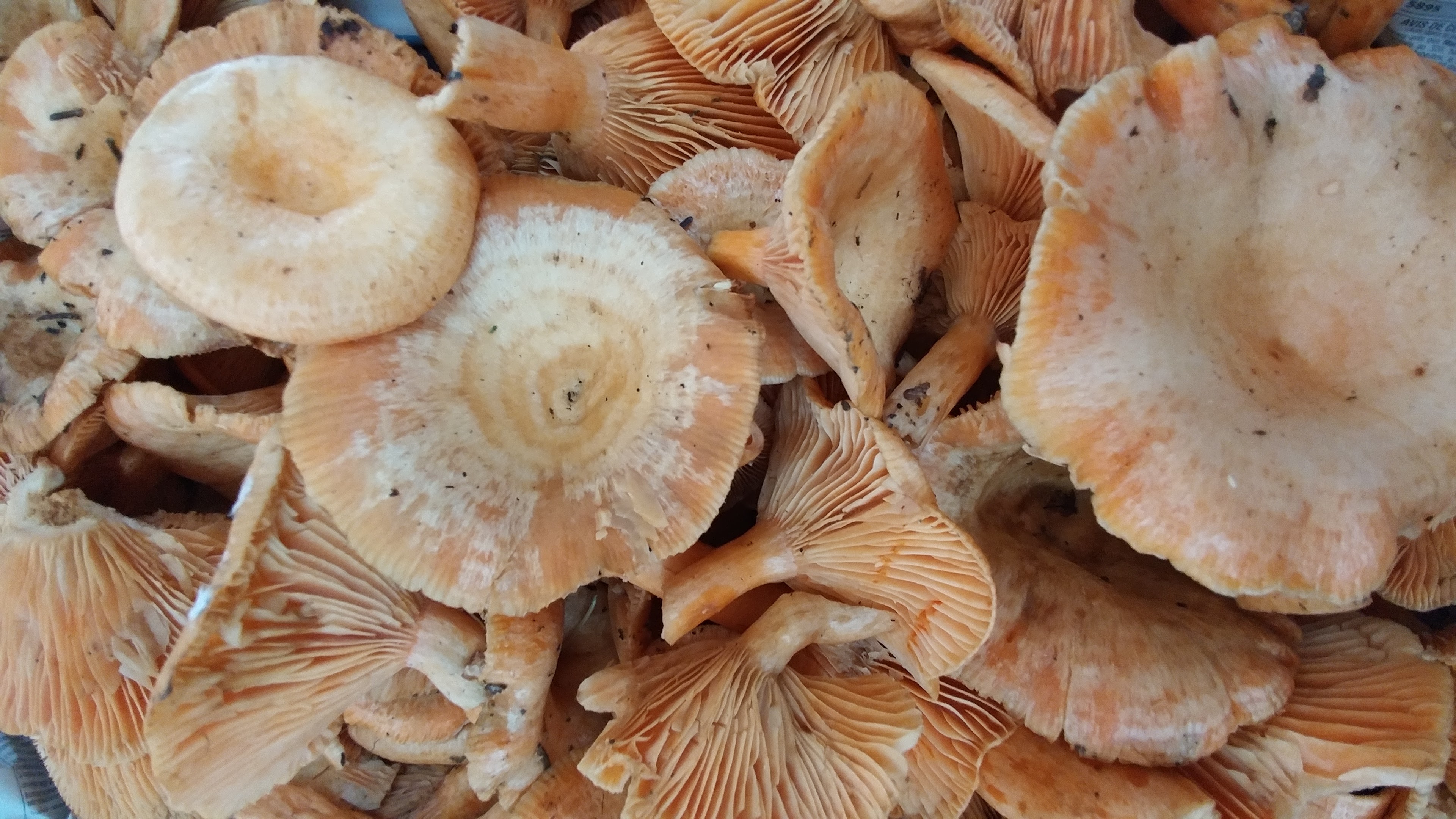 Lactaires Delicieux
Lactaires Delicieux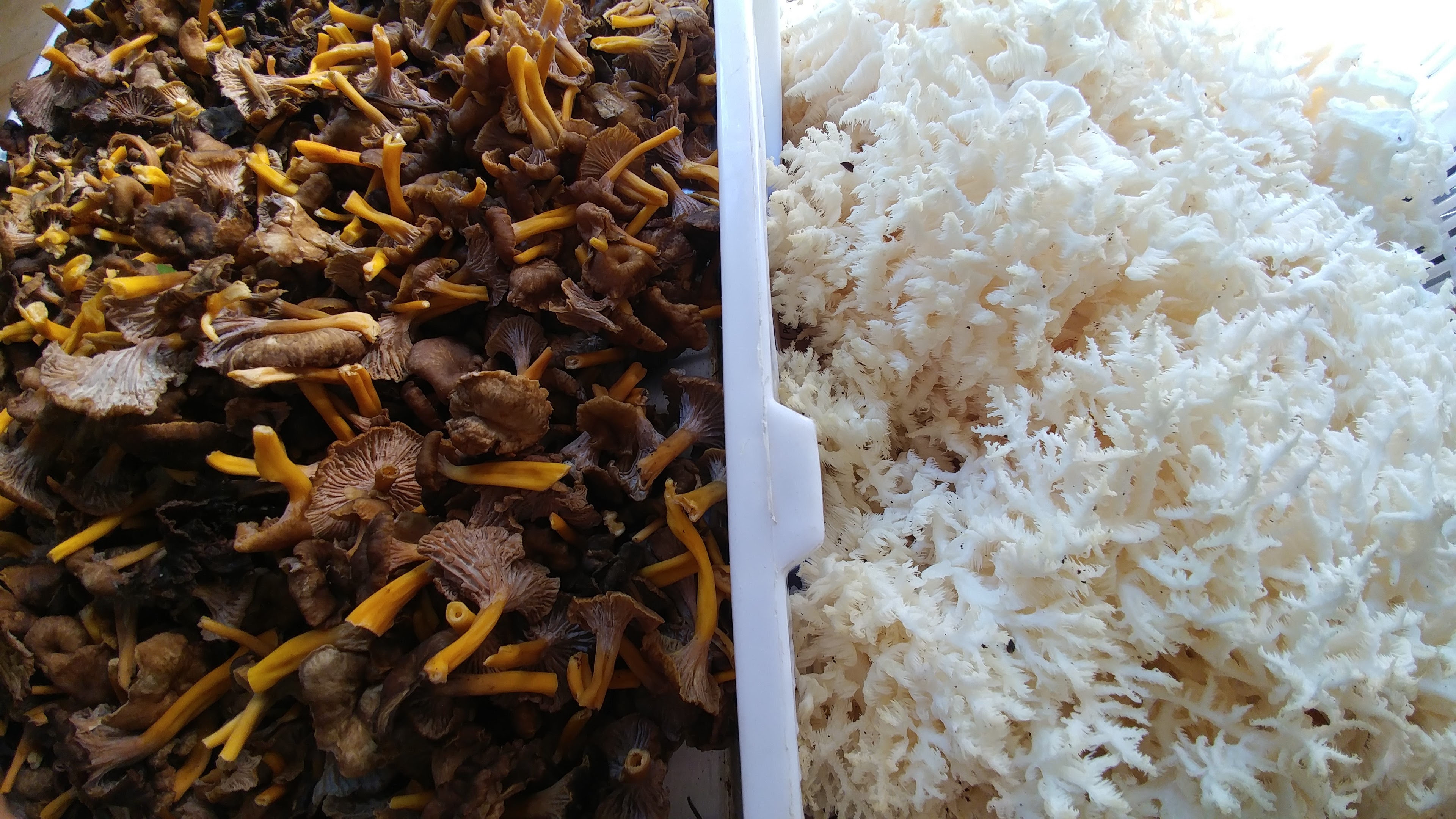 Comb tooth and Yellowfoot Chanterelles
Comb tooth and Yellowfoot Chanterelles
François' tomatoes, and a few summer recipes
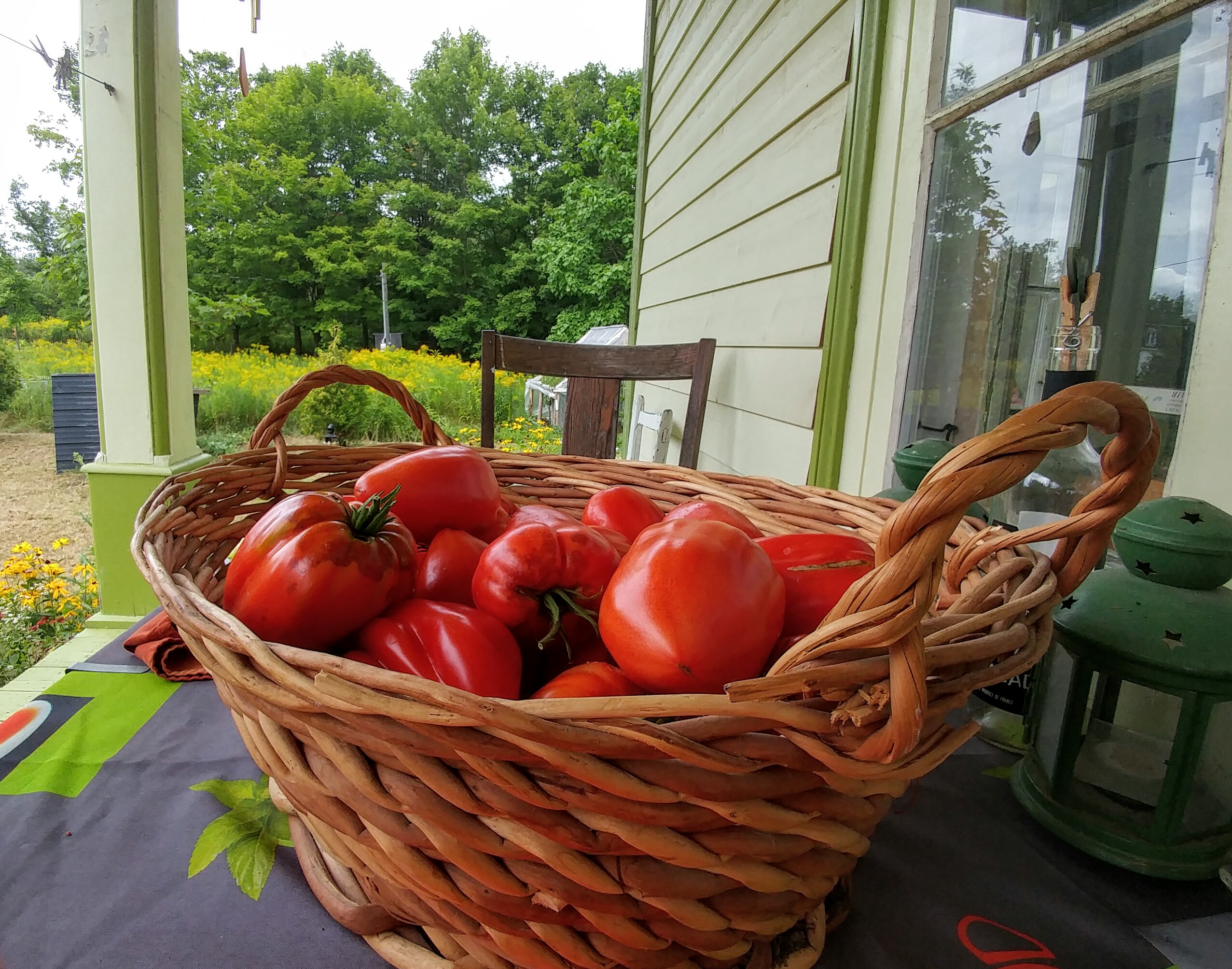 We may as well talk about tomatoes since there isn’t much going on in terms of local mushrooms. What a crappy season so far. I mean we’ve had a few good harvests but we are not meeting the demand at the market, and with a trickle for the restaurant menu, I haven’t started putting up. When you consider that I typically process 2 tons of mushrooms for our year (to supply the restaurant and make our products), I will have to get started soon enough.. Pretty frightening. Fingers crossed.
We may as well talk about tomatoes since there isn’t much going on in terms of local mushrooms. What a crappy season so far. I mean we’ve had a few good harvests but we are not meeting the demand at the market, and with a trickle for the restaurant menu, I haven’t started putting up. When you consider that I typically process 2 tons of mushrooms for our year (to supply the restaurant and make our products), I will have to get started soon enough.. Pretty frightening. Fingers crossed. 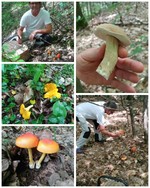
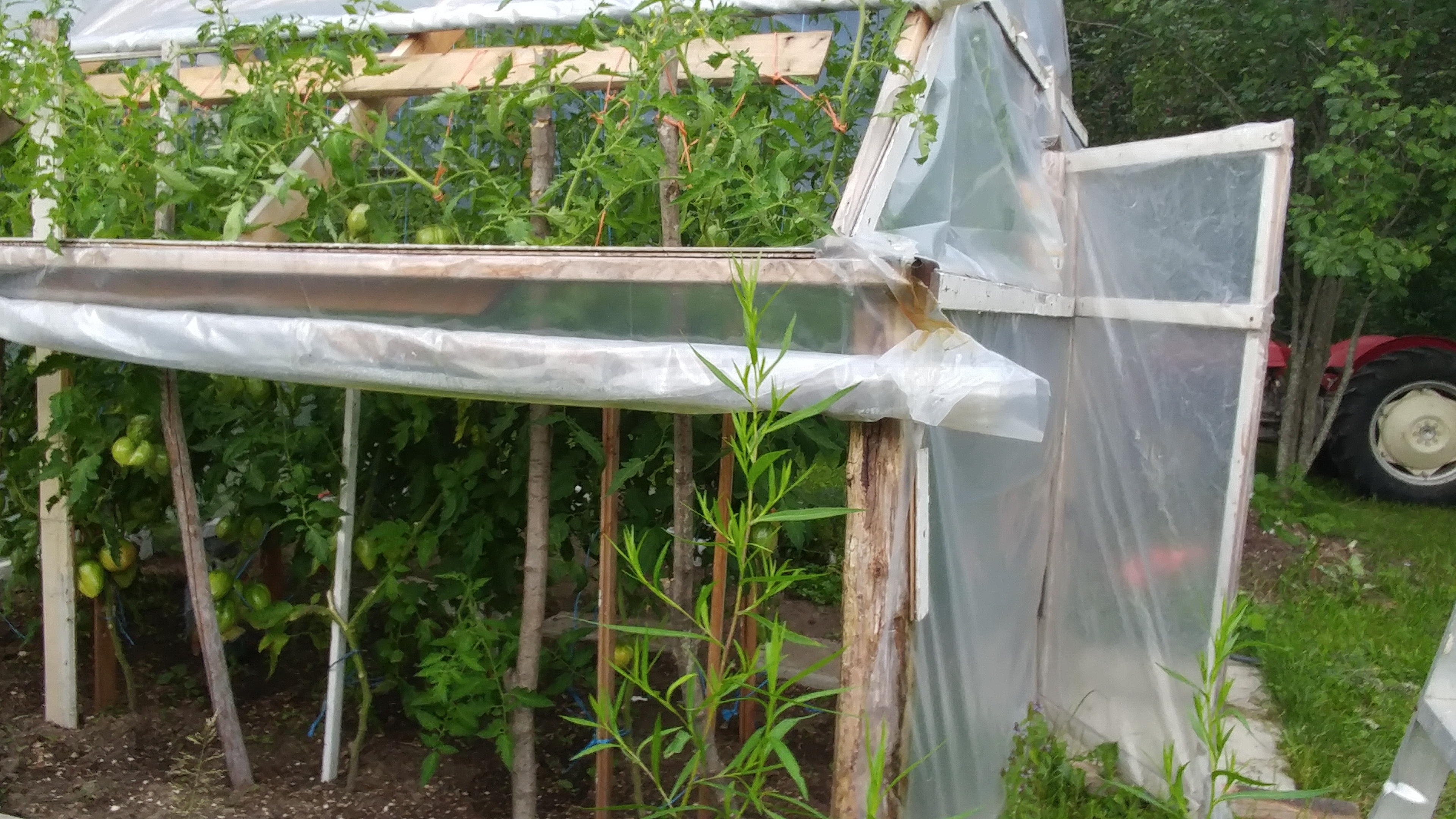
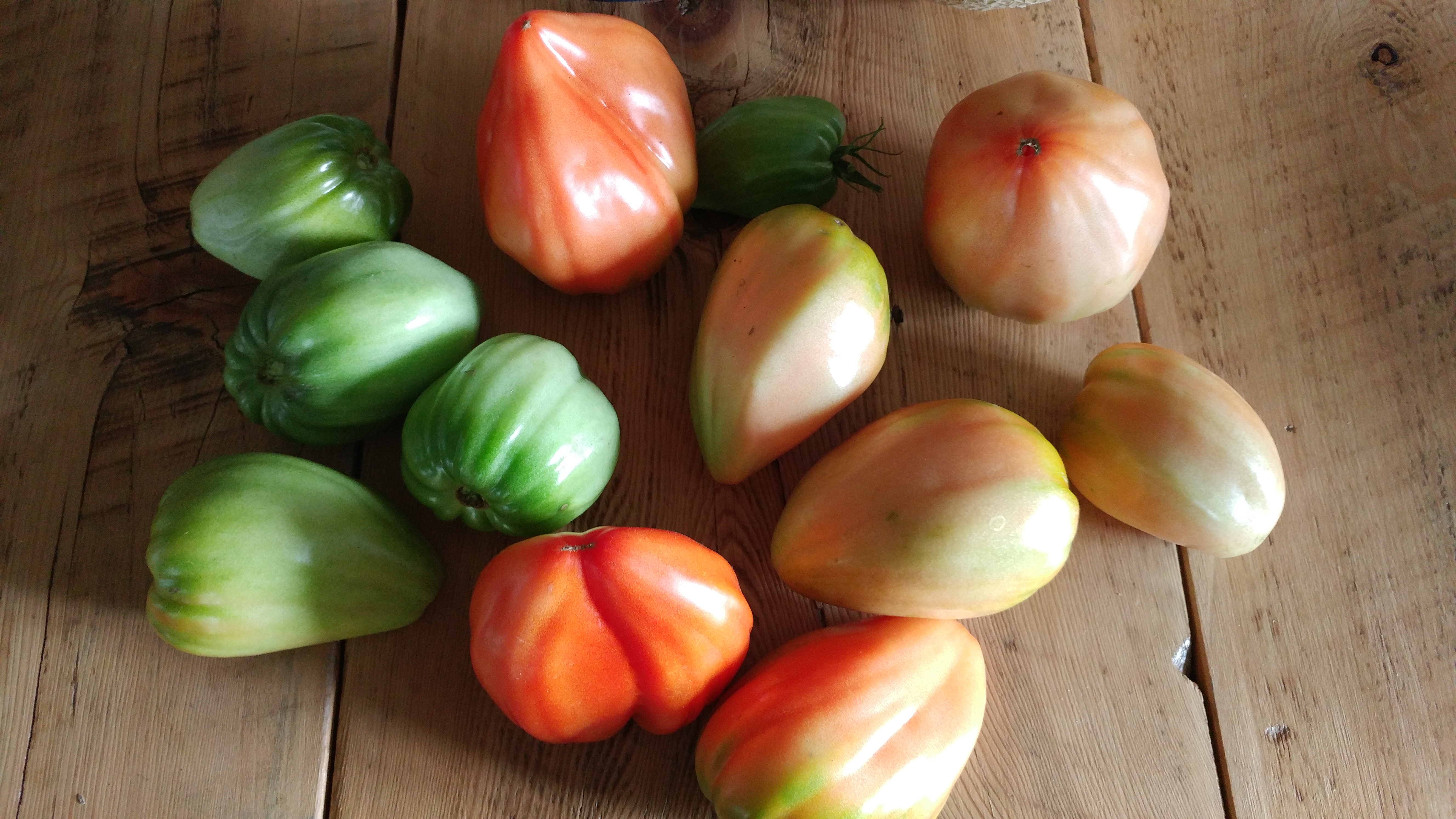
So anyway, back to the tomatoes. Anyone who knows us (or follows me) has heard of François’ famous tomatoes. They are an old heirloom variety whose name eludes us, from seeds passed down generations in Pasquale’s, (one of his Italian mushroom pickers) family. His great grandfather brought them over here like a century ago. François kept the seeds from the tastiest of his specimens and started them this winter, moving them into a greenhouse in the spring, and he lovingly tends to them every day with water and suckering, tying them up (they are 9ft tall!) and etc. He has planted some in the garden too and distributed seeds to other gardeners as well, in hopes to keep the variety alive.

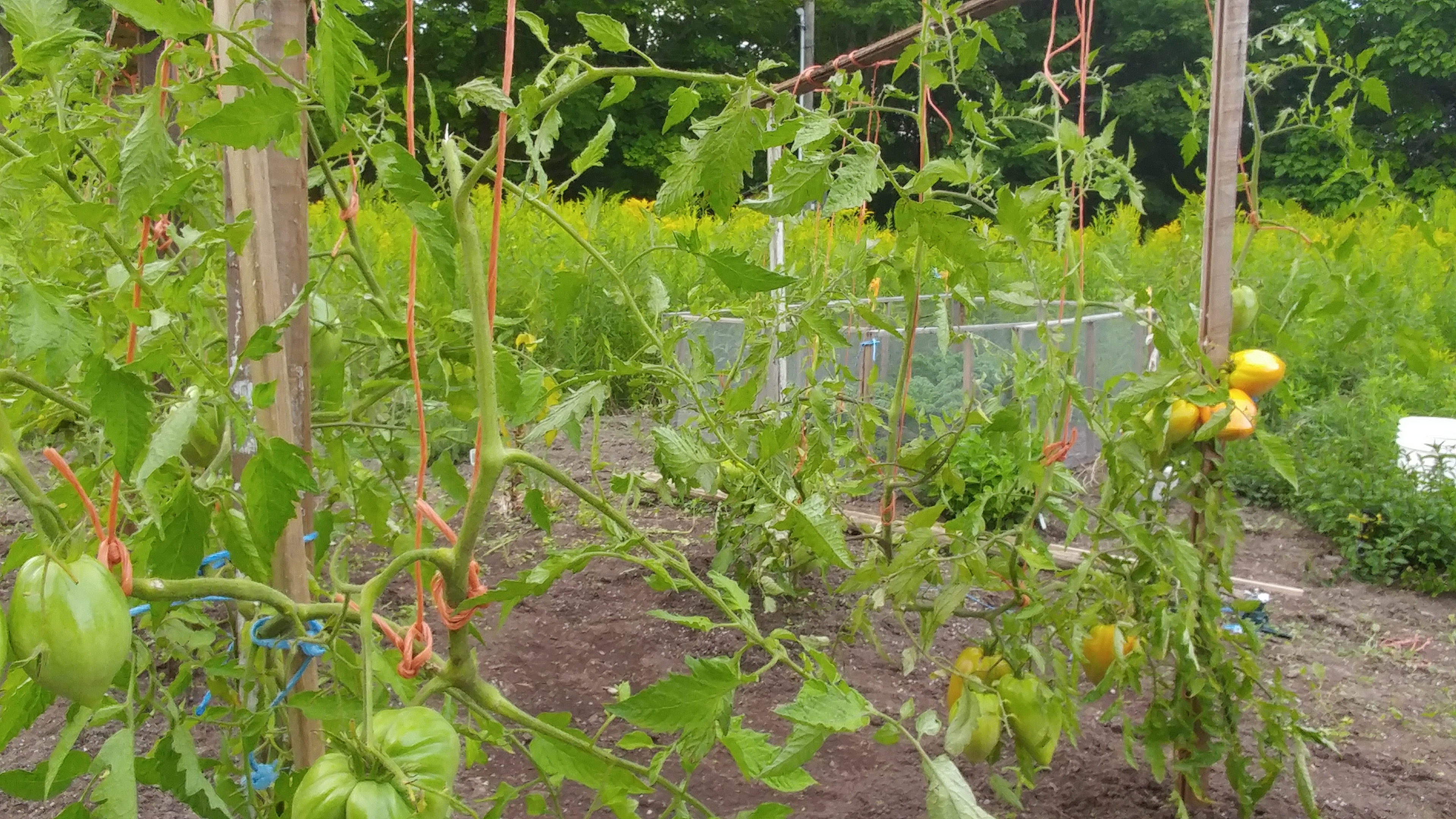
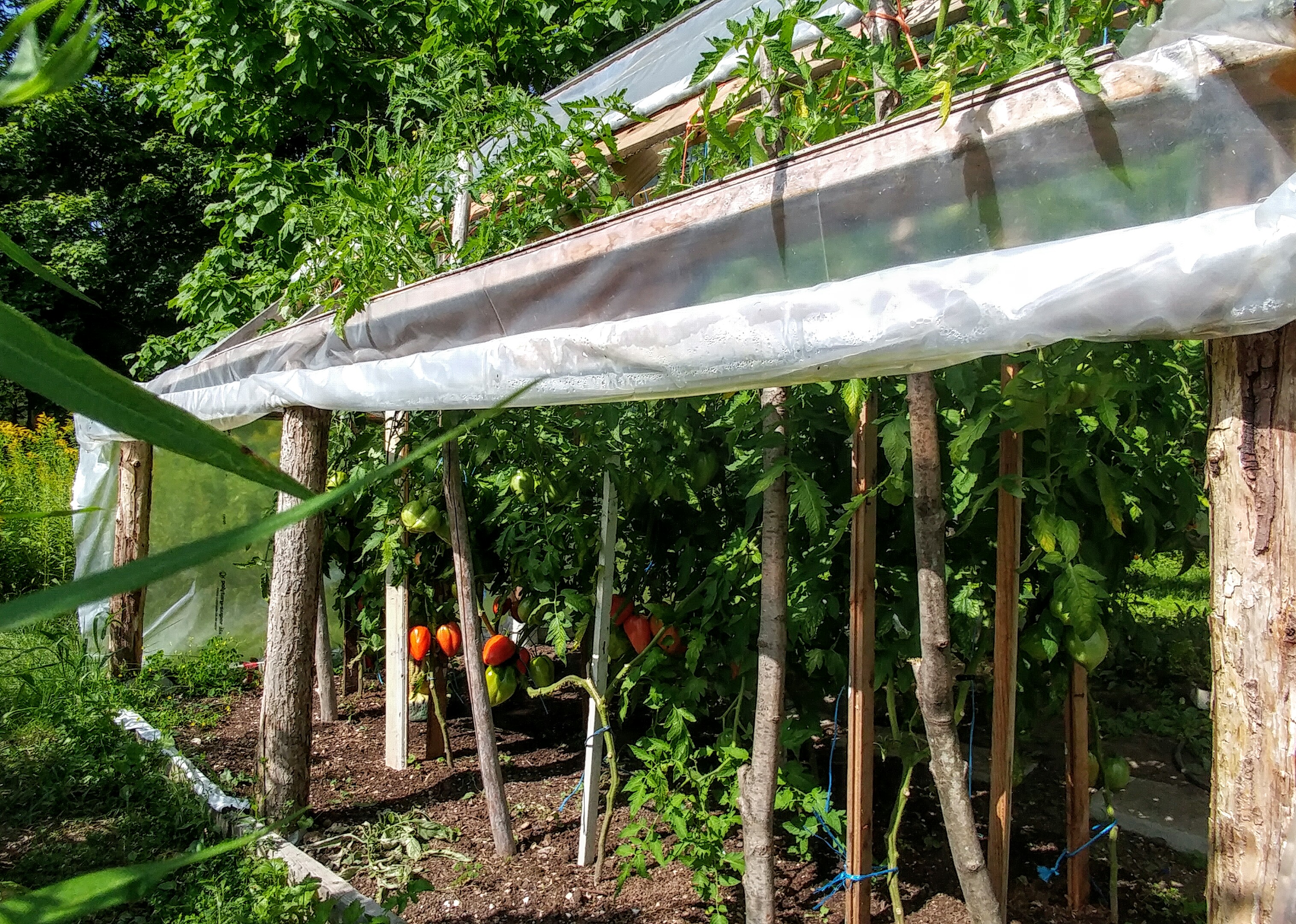 Greenhouse vs field, the taste test is on..
Greenhouse vs field, the taste test is on..
 Proud green thumb
Proud green thumb
I can’t tell you how important his tomatoes are to him, and hence what an exciting time it is in our household now that they are finally becoming ready. He lays them out on the counter in order that they will be eaten and for different uses.. Woe and behold if I take too many to the restaurant or if I chop up the one that was meant for a sandwich, or yikes, slice it ‘the wrong’ way - Watch out for the St-Roch tomato police!
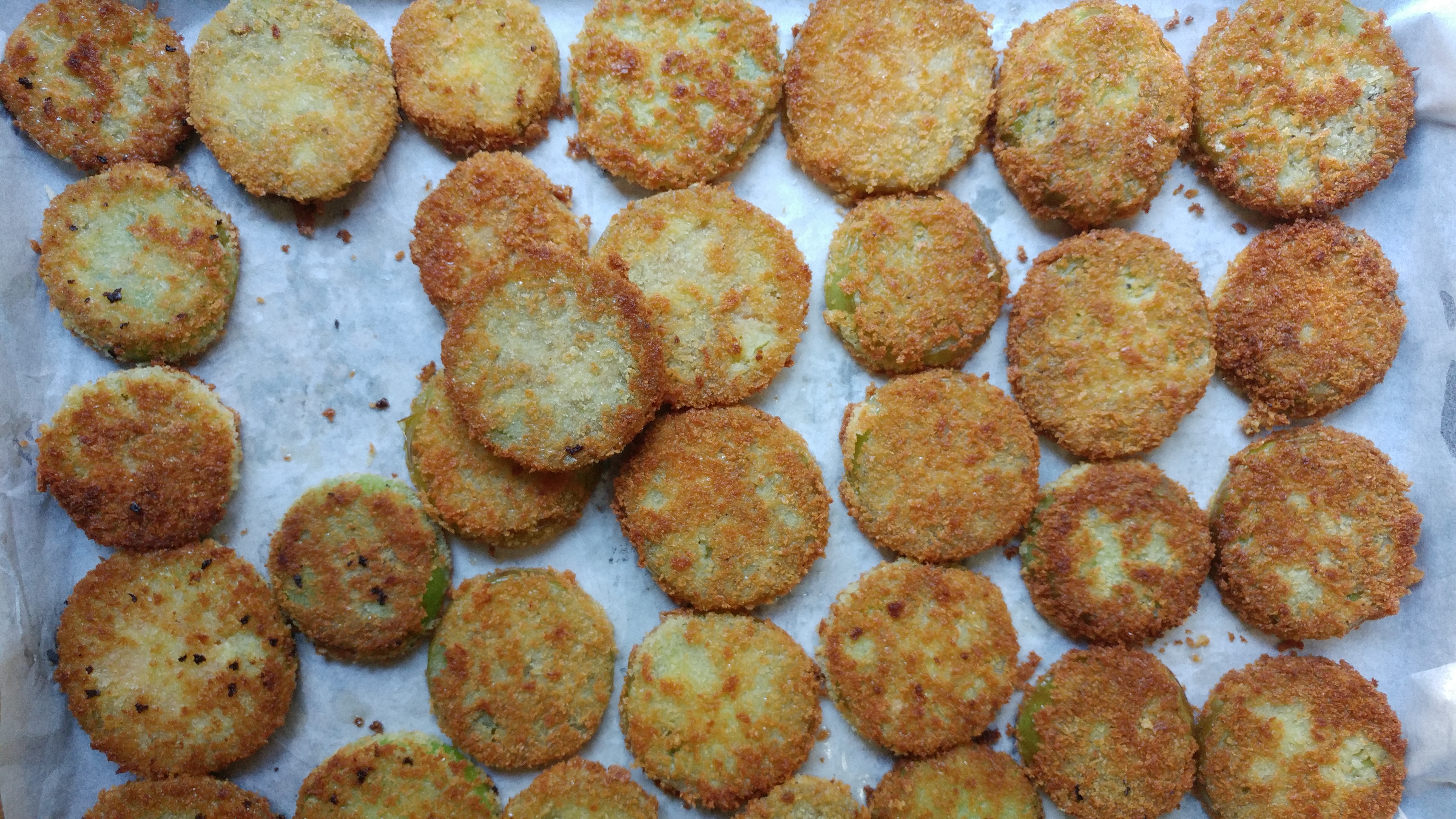
The first dish was of course Fried Green Tomatoes, which has become an annual ritual since we started making them (http://soupnancy.squarespace.com/blog-journalessays/2009/10/7/fried-green-tomatoes-finally.html), François just adores them. And besides, what else are you going to do with green tomatoes. Now that they are ripening, we are eating them in salads and salsa, with pasta and fish. They are meaty, not many seeds buy juicy, sweet and tomatoey, with a bit of tart. I like some acidity but François expects them to be succulent sweet and is banking on the garden ones.
He apparently has tomato tarts and pizza on the agenda, as he has ordered his dough (from me)..
At the restaurant – 1st entree of the moment: Fried green tomato with ripe and smoked tomato, corn, cucumber salsa, sea spinach and sea asparagus, crinkleroot lovage yogurt dressing, smoked eel, bee balm 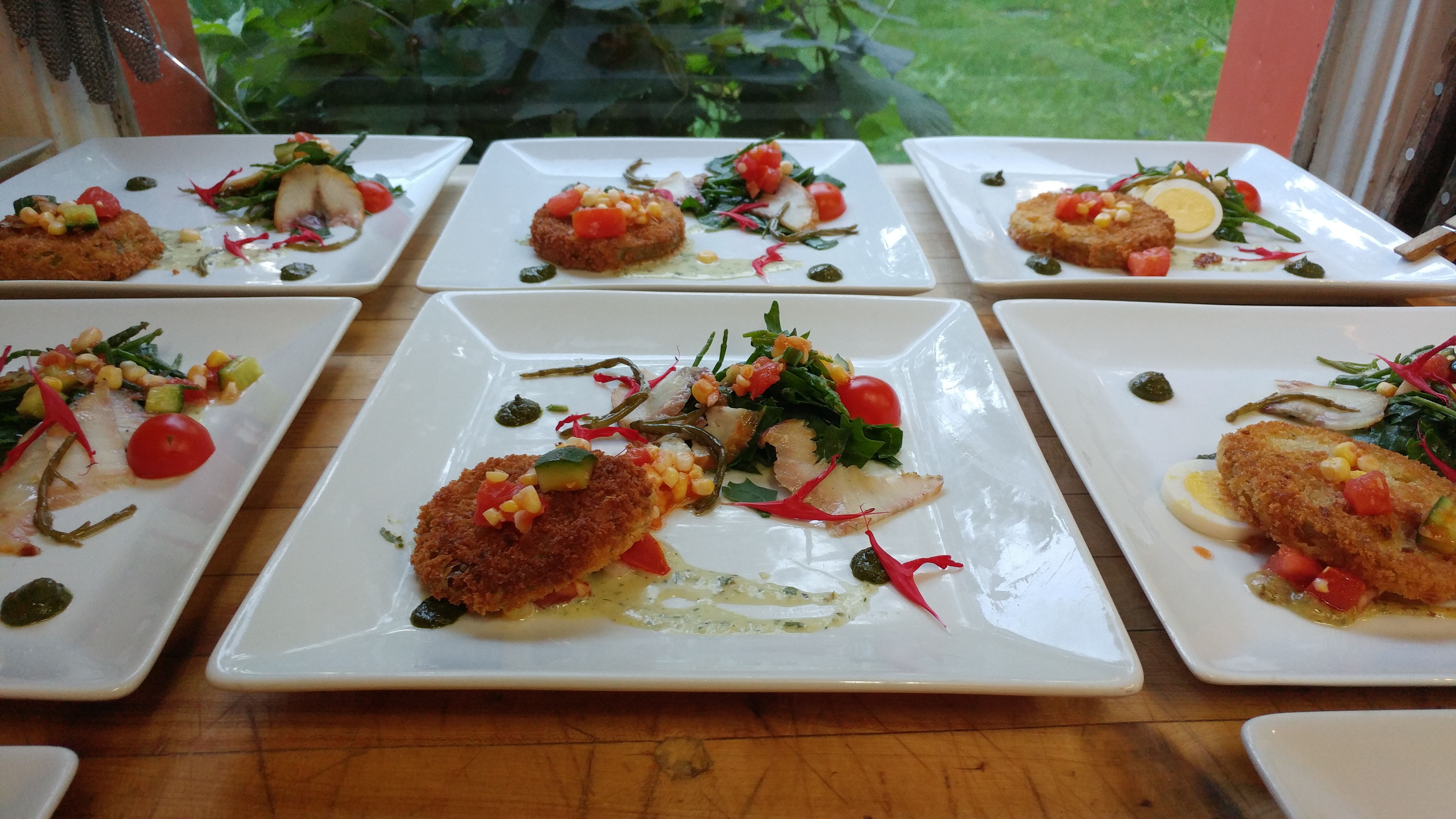
As the harvest really explodes later this summer/fall, I will be canning, smoking, making ratatouille and ketchup, etc..
But it’s not all about tomatoes or even the wild edibles, with the corn and beans, peas, favas, zuchinni and peppers, garlic, kohlrabi.. Lettuces, herbs, Plums, melons and peaches.. Not to mention the wild blueberries! And it will only get better in the month ahead, alongside the mushrooms. September is the best month of the year for food!
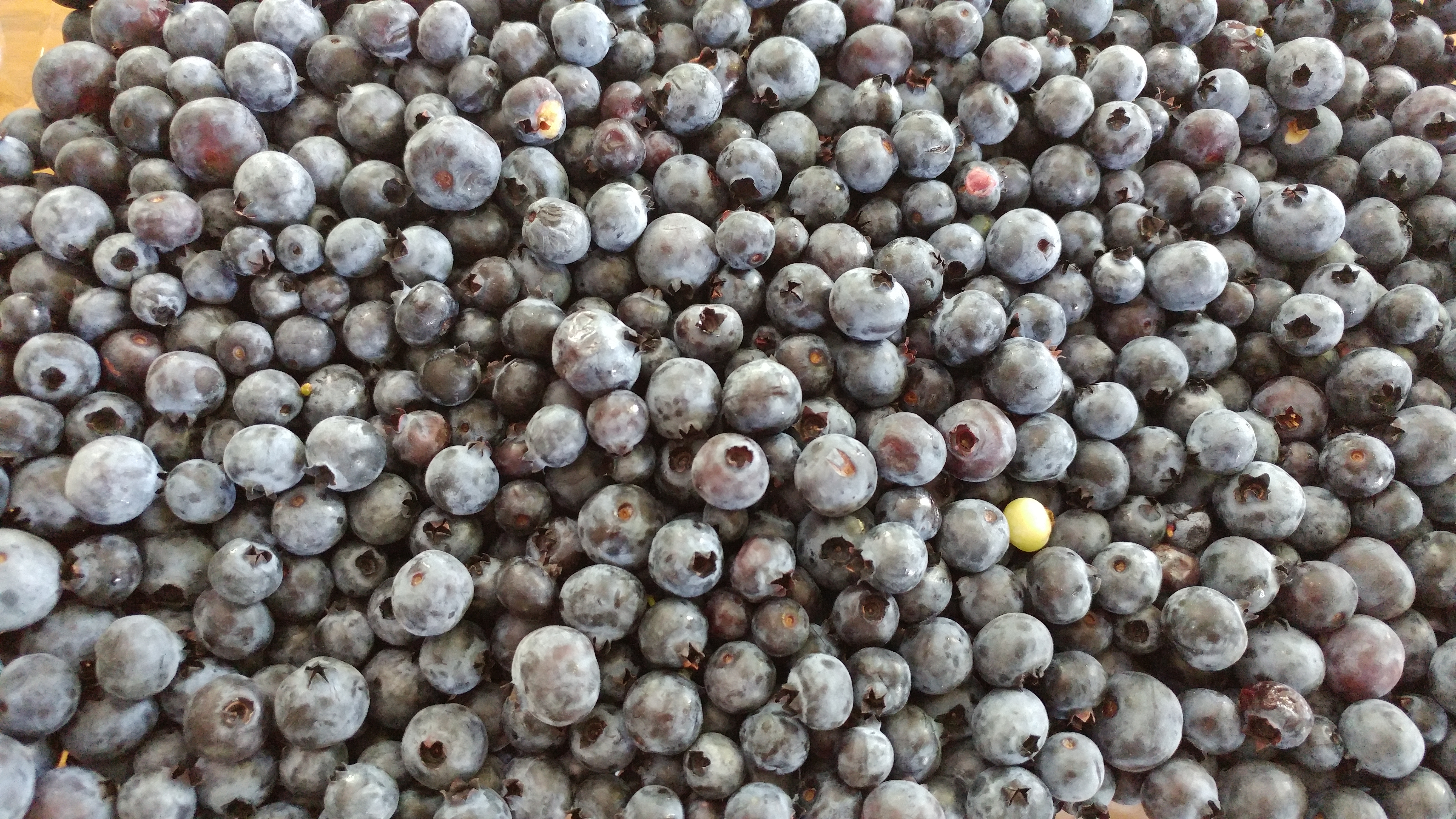
Some other summer hits:
A vegetable stew thickened with bread: ribolita - panzanella meets ratatouille, just a different delicious way to use the garden bounty or what’s hanging out in your fridge. Stew onions with celery/leek, peppers, add zucchini and whatever other veg you like (corn, beans..) Herbs and spices, A bit of white wine and stock or just tomatoes with their juice. At the end, throw in some croutons or dry bread, season and serve on salad with a good oil, aged vinegar and cheese shavings. Good as is or as an accompaniment to sausage, chicken or steak. At the restaurant, I was serving it with confit rabbit. 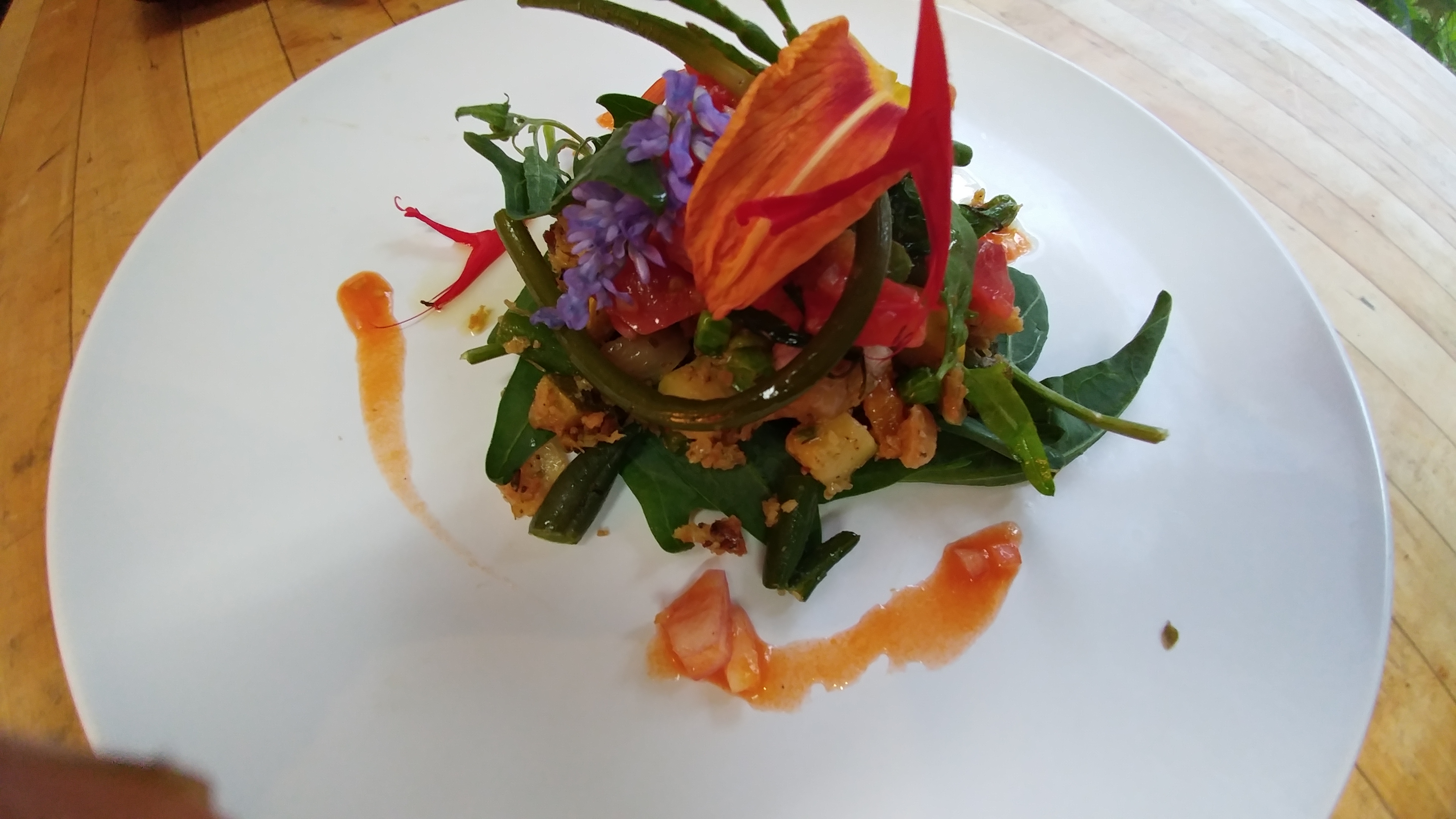
Fleur d’ail (Scapes) as a vegetable and as a condiment
In July when it’s scape time, we put them up for the year, alongside the wild stuff, a raw, green garlicky pesto. But it’s a beautiful time and a 2-3 week window (one for picking one, 2-3 for storing), when you can eat the scape as a vegetable, like an asparagus or green bean. It takes a 5 min. Boil. It is tender when it loses its bright green, sorry. Mildly garlicky, delish. Here the raw pesto is tempered into the hot potato mash, and the cooked scapes are a garnish. Alongside chanterelles which are in season at the same time. Just missing the corn, which would be perfect now. 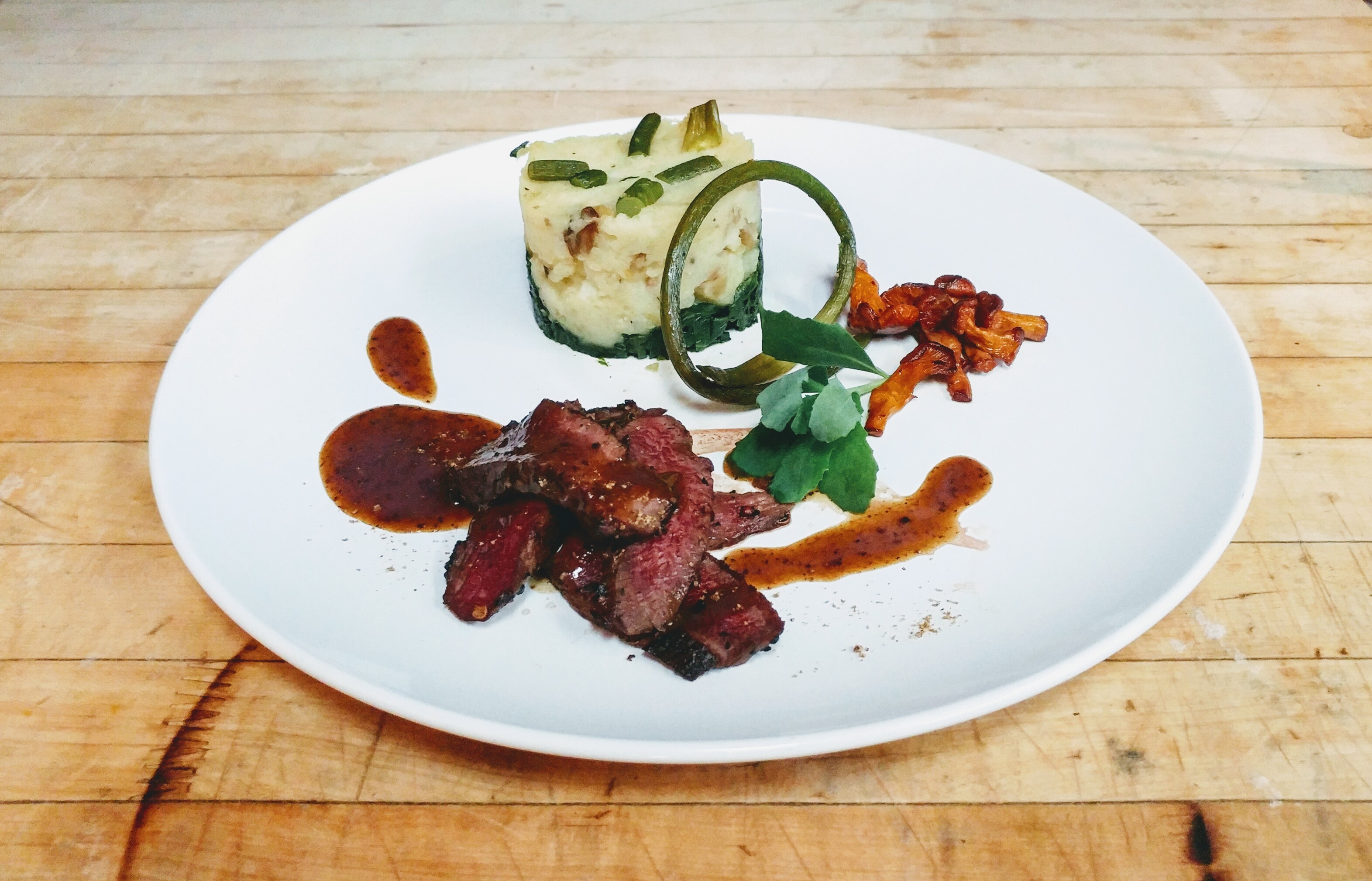
Vichyssoise (Stinging nettle)
Like a Parmentier or any puree/ green soup thickened with potato (so less cream). With stinging nettle and sea parsley, this soup is delicious, but it could be/is with many greens. I make a seasonal green soup with what is abundant, always good. Not only delicious, but nutritious. Served cold on a hot day or hot the rest of the time. Just a basic soup with onion, leek, celery, a touch of wine or vinegar, stock, herbs and spices, potato. Add wild greens. Finish with cream, milk. Tweak with salt, pepper, spice, acid, maple syrup.
Add a little garnish like this: cucumber, radish, lovage, sumac to lighten it up, or it could always be another to make it more hearty like bacon or smoked duck.
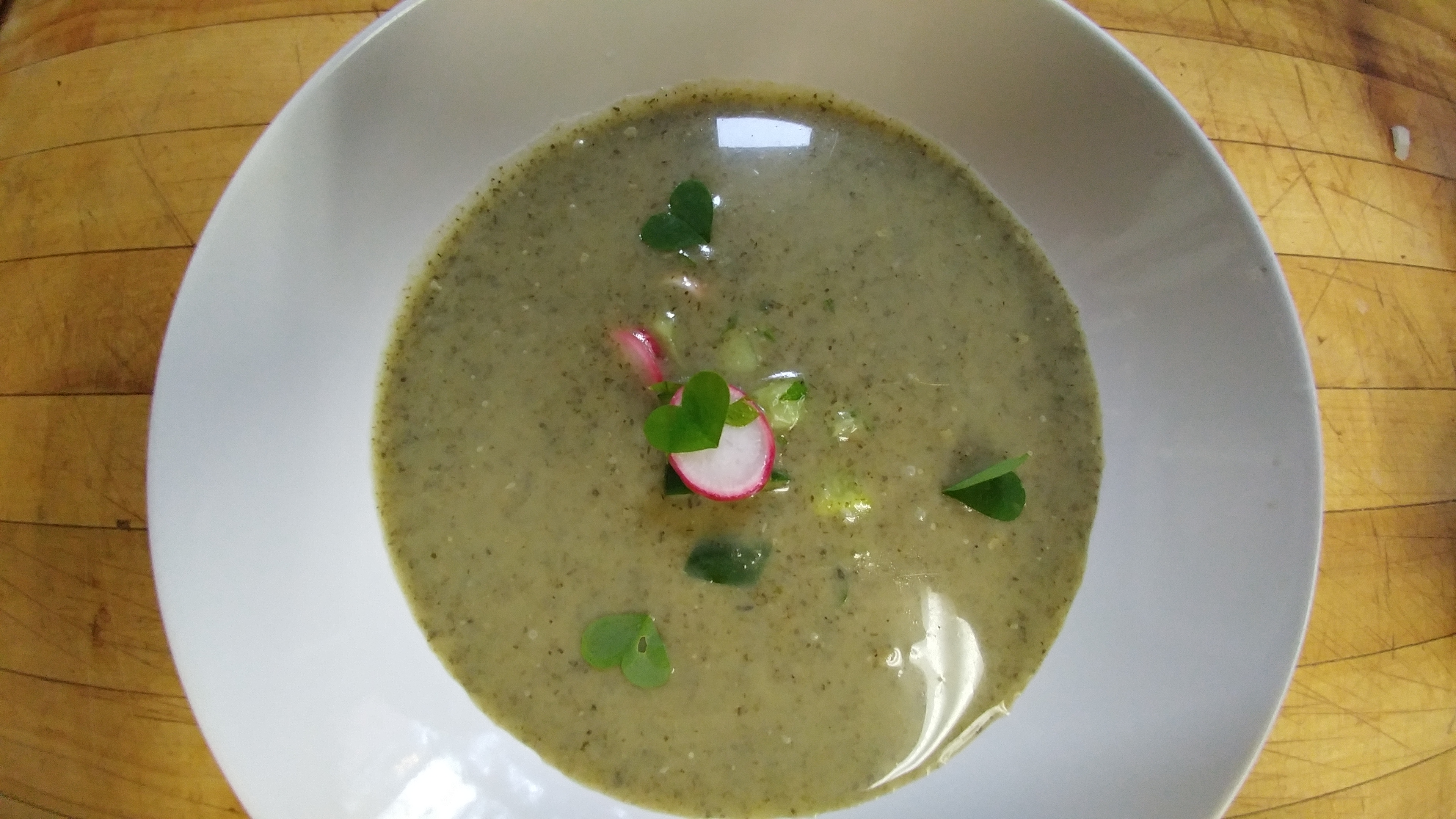
Mushrooms or not, it’s time to be hitting the market (and/or garden) and cooking up a storm!
 Lobster mushroom and lobster bisque risotto with beach peas, sea spinach and sea scallop
Lobster mushroom and lobster bisque risotto with beach peas, sea spinach and sea scallop 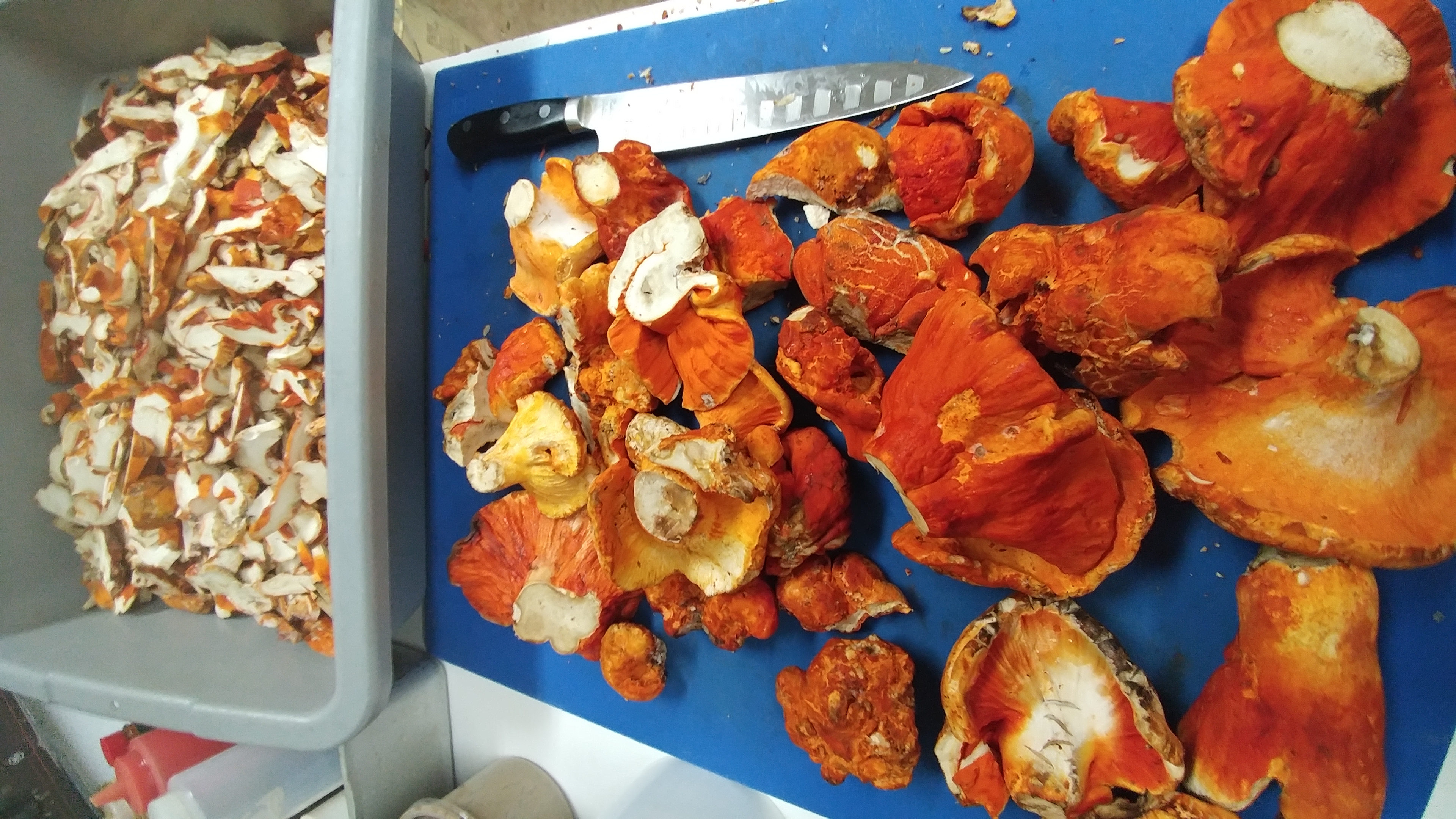 First significant harvest of Lobsters to put up
First significant harvest of Lobsters to put up
My guilty foreign flour affair '00'
My guilty foreign flour love affair
If you love pizza as much as I do, and like to make it at home, read on..
Maybe I’m late to the game on this, but I’m in love with Italian yellow flour ‘00’!
If you like to play with dough, you NEED to try it out. It is just so fun to work with. And it tastes great. I just love the texture it lends to the dough too. Although it looks like finely ground cornmeal, it is indeed wheat flour but milled differently, very fine supposedly, I guess by Italian standards because it is coarser than ours.
Being a girl that promotes local food pretty religiously and for some time now, naturally I buy all my flour from the mill next door (Le Moulin Bleu, St-Roch de l’Achigan).
My guilty affair with this imported flour started with my first No.900 pizza a couple of years back in Quebec City. It was simply the best pizza! Even my fussy François agreed. Dressed only with good tomatoes, cheese and salami and dripping with olive oil, it was the thin, blistered but soft-chewy crust that made it extra-special. Maybe this would be an occasion to use the silly word ‘toothsome’.
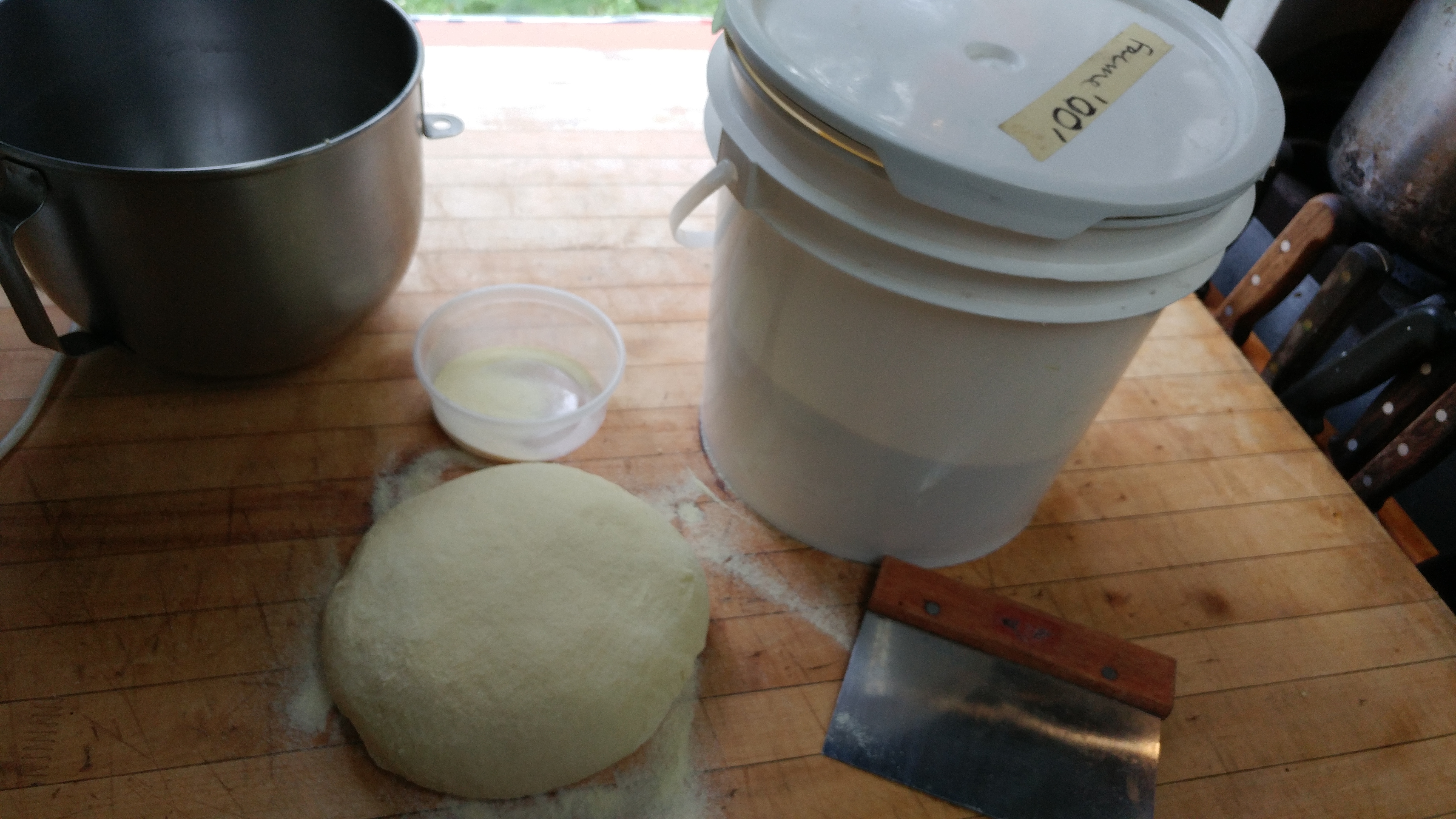
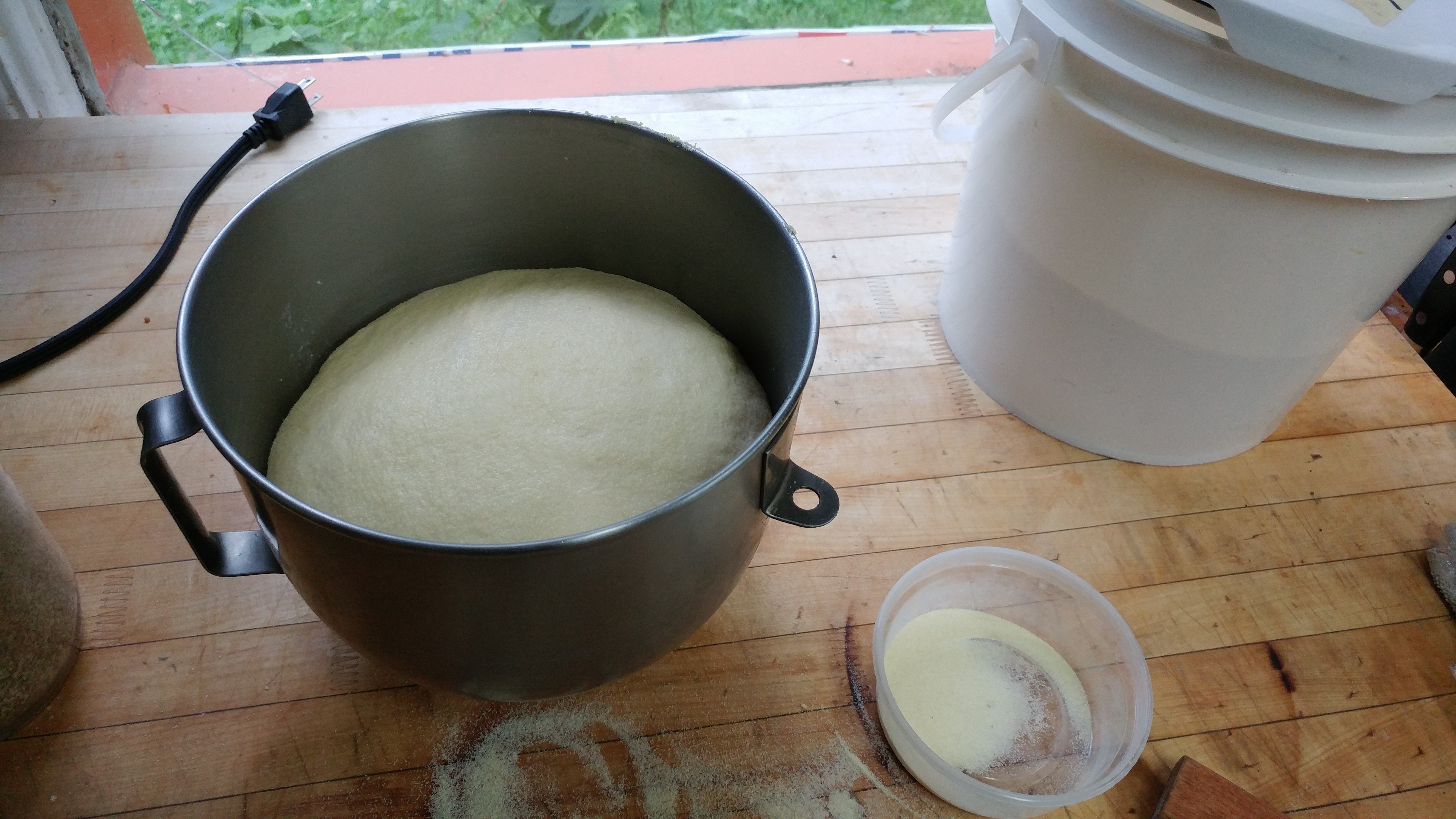
Since my first year of professional cooking 24 years ago and early job in an Italian restaurant (Picolo Diavolo in the village), I have been making pizza. And I have the burn marks to show it on my arms. I don’t make it at Jardins Sauvages except for fireside friend parties, the occasional catering event as finger food, but yes, regularly for us at home, for me. It is never a meal, but the perfect snack, say late night or during a kitchen shift. I always have dough in the freezer, if not a ready-made pie. François likes it white, which is good especially loaded with wild garlic and crinkleroot and some wild greens (so green). I prefer it red with my put up tomatoes, cheese of course and something salty like a cured meat or olives, definitely some spice and occasionally maybe even something sweet like a pickled pepper or ratatouille. But only as a garnish, absolutely not too much topping. But I have a hard time not putting too much on the pizza, like on my plate.
Anyway, the important thing is the crust. The dough at that first spot I worked was a thin crust baked in a wood oven, back when that was a new thing on the scene here; it was rich in that it had milk, eggs, a bit of sugar and all purpose flour, more crisp than chewy. I’ve come back to it several times over the years, after experimenting, but most often doing a simple basic 3hr affair with 65- 70% hydration, just salt, yeast and a touch of olive oil. But now, all while working on the chew, I do like to add one egg for the crisp/taste factor, otherwise a basic dough.
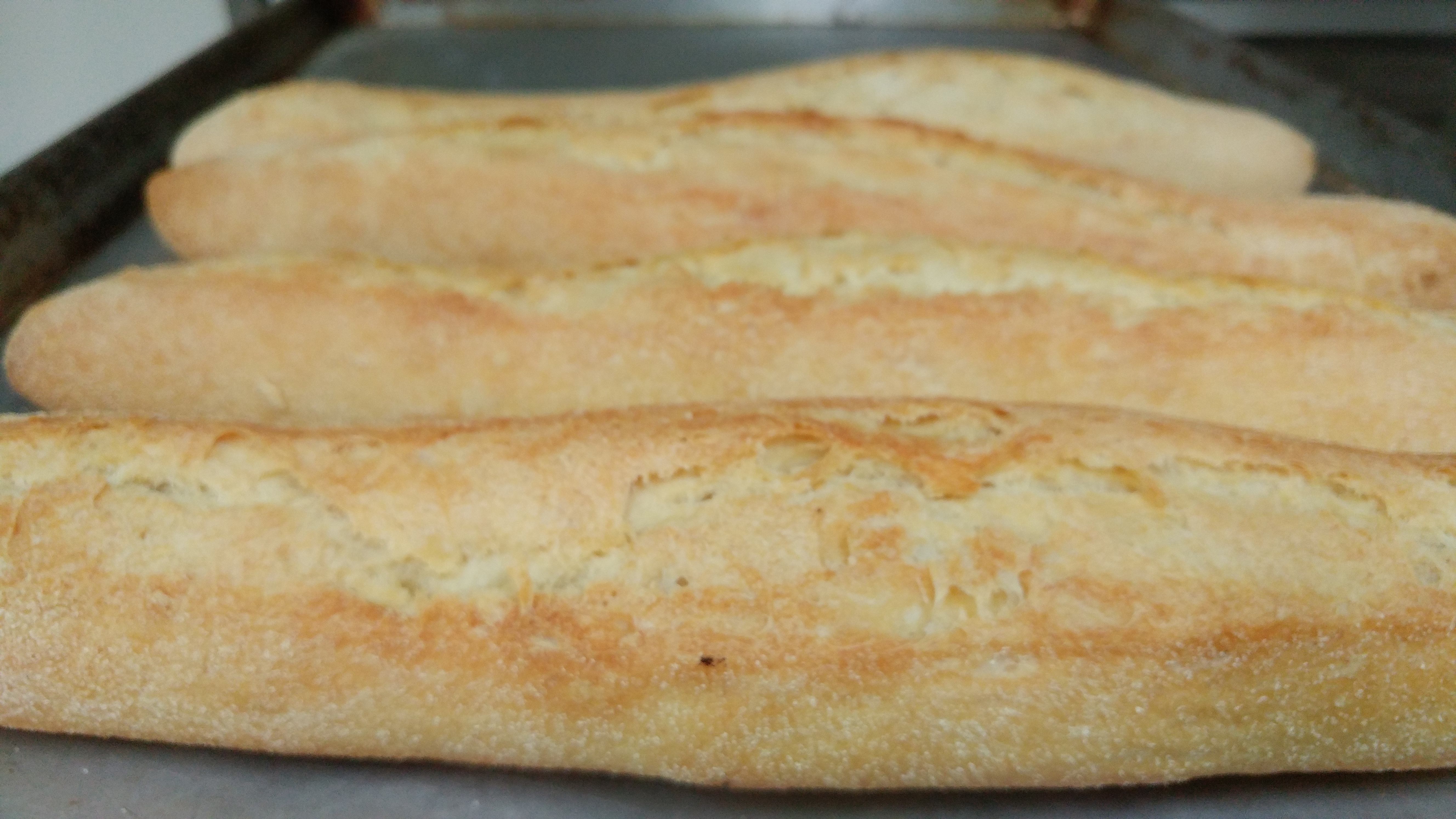
Of course, I went through the no-knead trend but although it’s a neat trick, you have to start the day before and it doesn’t really produce the best results. Especially with bread dough, I have ditched the no-knead laziness however often it saved my ass in the past (the Instadough recipe I learned at the Cordon Bleu was a go-to when busy).. No longer with Leonard (my beloved levain who passed a while ago), I now have a younger less complex starter that sometimes requires work in the days before, but I prefer to make the final dough same day and yes, knead. I make pretty good bread given my set-up, and I enjoy it. If I was in the city and had a fantastic bakery around the corner, I would probably outsource but here, it happily makes sense that I bake my own bread.
All that said, I have never been super ecstatic with my pizza dough, often settling, always fiddling. It’s also in my nature. I can’t just follow a recipe, always working on the ultimate one that I forget to write down. In any case, I know I don’t have the proper oven, can’t attain those ideal ultra-hot temperatures. And yes, I tried a baking stone, rocks from the river and etc. At one point (this must have been early in our relationship), François spoke of building me an old fashioned bread oven; he has the plans and the stones. But we both know that’s ridiculously inefficient in terms of the wood we would need to burn for our small, sporadic operation and a family of 2; ideally that sort of thing would be for a community of bakers or a full-time bakery/pizza place.
Besides the fancy 900 degree oven I will never have, I figured I might come closer to that crust I dream about by trying the famous yellow flour used at No.900 and by many Italian pizza aficionados..
And yes, it is pretty amazing! Mind you, you can’t follow a regular recipe for it, but I just played within my ratios and added the flour needed. It’s incredible how elastic it gets. 1 cup of 00 weighs 200g compared to around 150g for most all-purpose or bread flours. But it absorbs less water, so you need more flour than you think. But if you’re working in cups, you end up not being too far off I realized.. Since I usually work with weights in bread, I stopped following any recipe, followed the feel and the fermentation. With the extra flour in weight, I saw I had to up the salt. I haven’t found that you need more yeast, but maybe a pinch. It depends again on if you’re using a starter or what your timeline is. If you have a starter or want to take it slow, you will add less yeast, say. Don’t be too harsh, punching down your dough and such, it’s good to be gentle. I am often tempted to roll out but stretching by hand apparently gives a better crust.
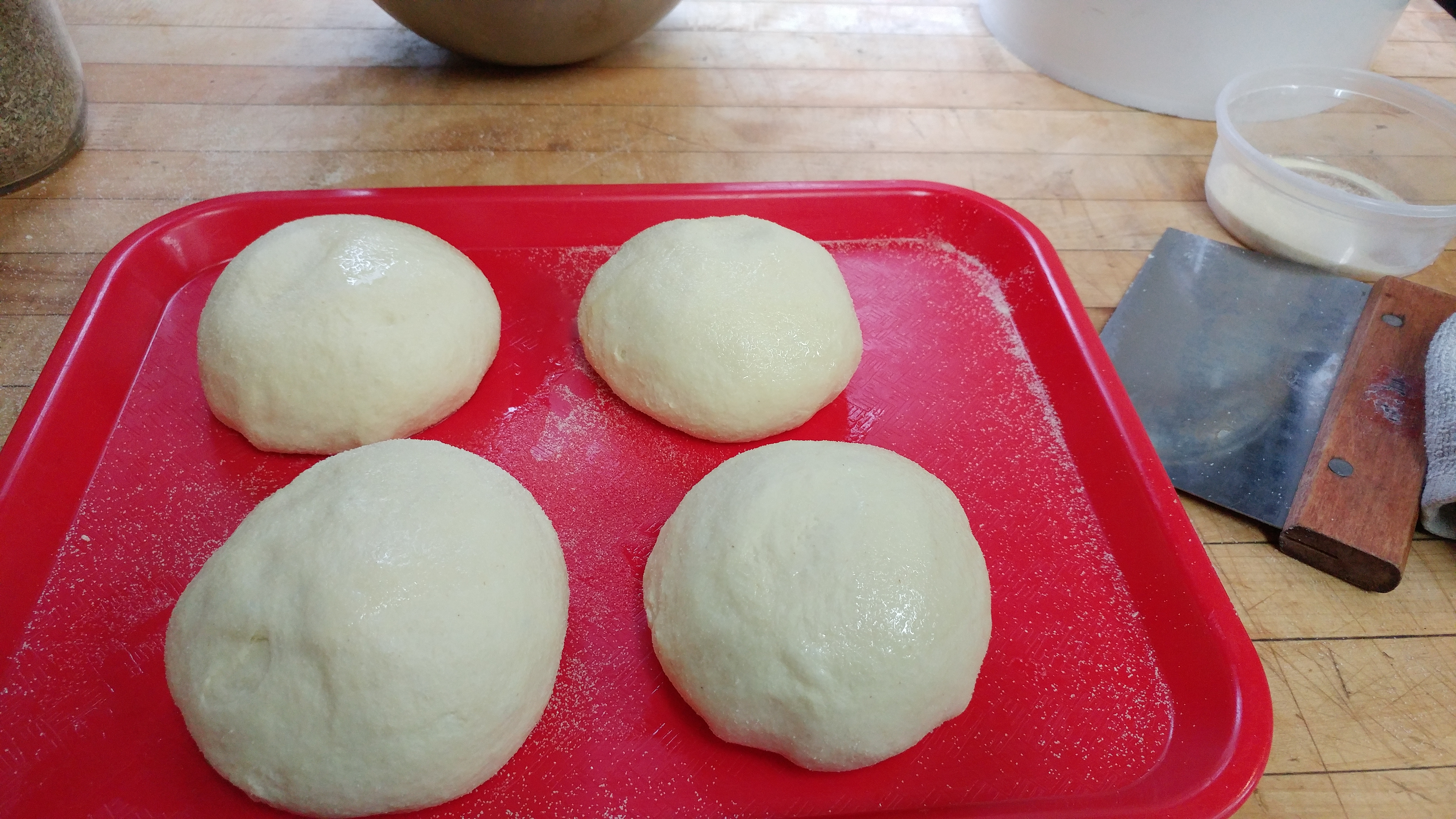 Dough balls for the freezer. Takes no time to thaw for same day pizza if not overnight.
Dough balls for the freezer. Takes no time to thaw for same day pizza if not overnight.
It’s still not perfect, but steps and bounds ahead, for a home kitchen. You can see my recipe template below and others too.
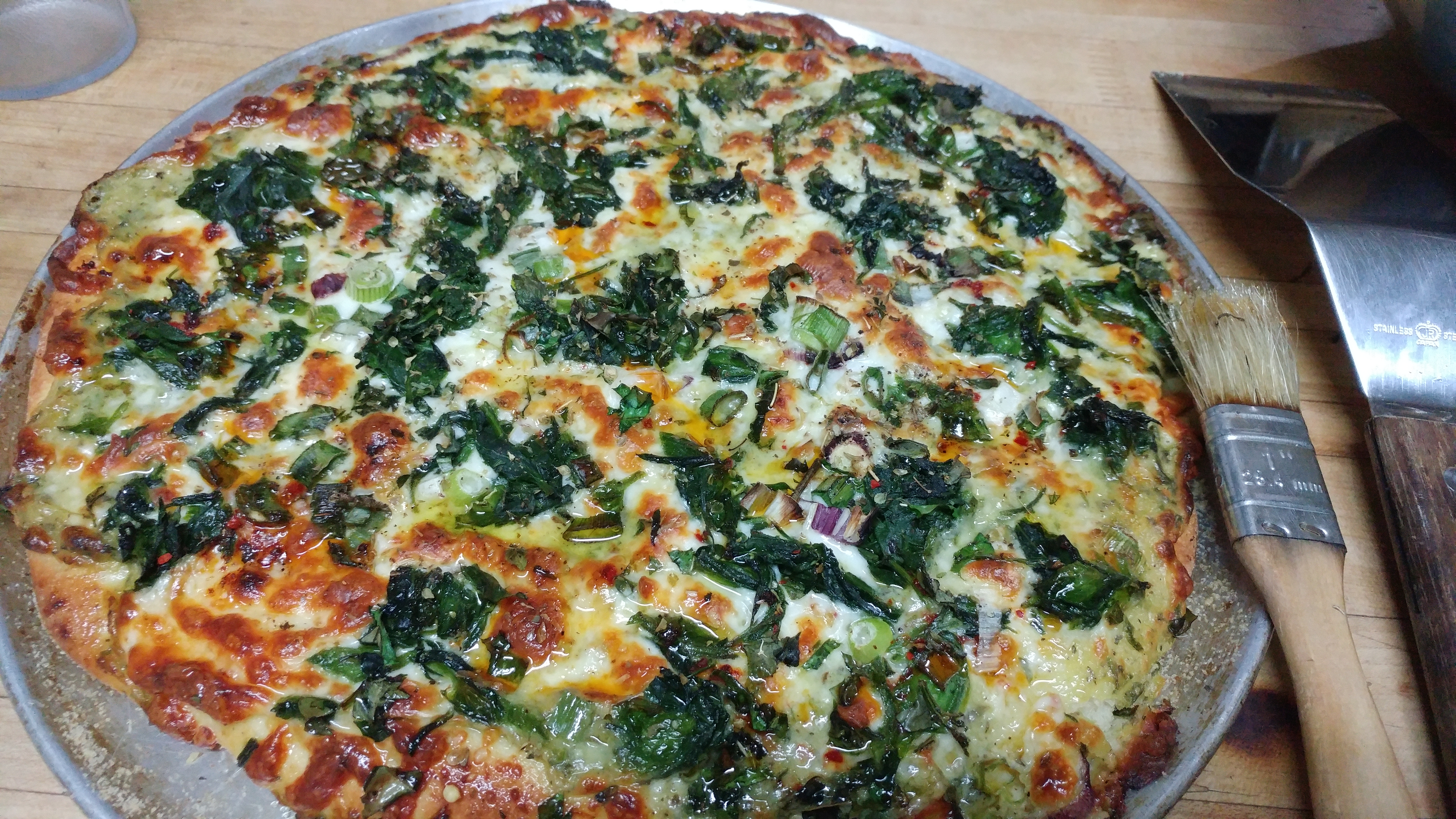 This could have been rolled or stretched thinner, less topping. But it was still delish.
This could have been rolled or stretched thinner, less topping. But it was still delish.
I said I would use the 20lb François gave me as a Xmas gift, because it was a super gift and I don’t want to be wasteful. I have been using it in my bread at la table too (along with Le Moulin Bleu, say 50:50 or just to feed the starter or just to finish) much to my waitresses’ bafflement, given our local credo. I told them it was just a fling. But I’m almost out, so I don’t know. Maybe more than a fling, because I might have to buy more, if only for my home pizza snacks. You can get it at specialty Italian stores or suppliers, not too hard to find in the big city or online I suppose.
And it makes the most fantastic pasta too! I use half Moulin Bleu bread flour and half '00'.
Fliing or not, the Moulin Bleu will remain my go-to and should be on your radar too. Local and organic, especially known for their buckwheat.. I don't know, but it doesn't really make much sense to import flour. So torn.
My more-or-less recipe (pretty darn good but still room for improvement)
2x large or 4 x medium 12’ pizzas:
10-15g yeast (1-2 Tbsp or 1-2pkg) active dry*
400ml water (slightly warm to body temp) or 1 egg + 350ml (total a little more than 1.5 c)
15g (1 Tbsp) sugar
700g+ 00 flour (around 3.5c), more like 550g of AP flour or Moulin Bleu bread flour+
20g (1Tbsp salt)
20ml olive oil (1 big Tbsp)+
Mix water, sugar and egg, add yeast. Add a third of the flour and mix. Allow to hydrate a little, say 20min. Add another third of the flour, salt, oil and start mixing. Once you have a sticky homogeneous mass, add the rest of the flour except for a bit, that you will add as need be. Knead at slow/medium speed, adding more flour as required until a uniform mass /loose ball forms, and then knead a little more, but not too much. Like 5 min total by machine. Until it is an elastic, stretchy, slightly but not too sticky ball that gently pulls off the dough hook or your hands (by hand it will be longer, more like 10min). Let rise covered for 1hr or until double. Cut into 2 or 4 portions and roll into balls. At this point, I put them on a greased tray and freeze, wrapping the next day for later use. Then you pull out a ball and let thaw in the fridge overnight or on the counter for a few hours, before rolling out/shaping. . If you are cooking soon, then let the dough rise another 30min-1hr before rolling out (onto a greased floured pan). Once stretched or rolled out, top and let sit while your oven heats up. Cook for about 10 min in a 450F oven. Go higher with a stone if you can. The hotter the better if your pie is thin, not too much topping. I have found that unrealistic in a home oven setting and with my pizzas. Because you want it to be cooked through and toasted, not burnt. Out of the oven, Brush with olive oil or good oil of choice.
*I find that if you’re not in a rush, it is best to use less yeast and take more time..
Our favourite toppings:
Tomato sauce (with garlic and oregano) spread very thin, you should see the dough through the sauce, cheese (ideally a blend of grated firm cheese like cheddar and/or parmesan-style, with some mozzarella or fresh cheese), prosciutto or salami, green onions, basil, hot pepper
Ratatouille spread very thin, cheese (same as above), olives
Bechamel or cream sauce or just drained fresh cheese with herb pesto (or a ton of chopped herbs and greens), some grated cheese, thinly sliced onions or wild garlic (optional: bacon)
Wild mushroom sauce, cheese
Wild Herb pesto, fresh tomatoes, cheese
3 Pizza dough recipes http://slice.seriouseats.com/archives/2012/07/print/the-pizza-lab-three-doughs-to-know.html
Spring meets Summer, Foraging issues and guidelines
Spring meets Summer, finally!
Although it’s still technically spring, it’s starting to feel a lot like summer. A deep, lush green abounds, a symphony of birds chirping, and yup, the mosquitoes are out in full force.
Our spring rush of harvesting shoots and fiddleheads is over. It’s always a mad dash to seize the short window and make the most of it. With a slow, cool spring, the greens were at their best - mild and crisp, delicious.
 François' 'shade' fiddleheads
François' 'shade' fiddleheads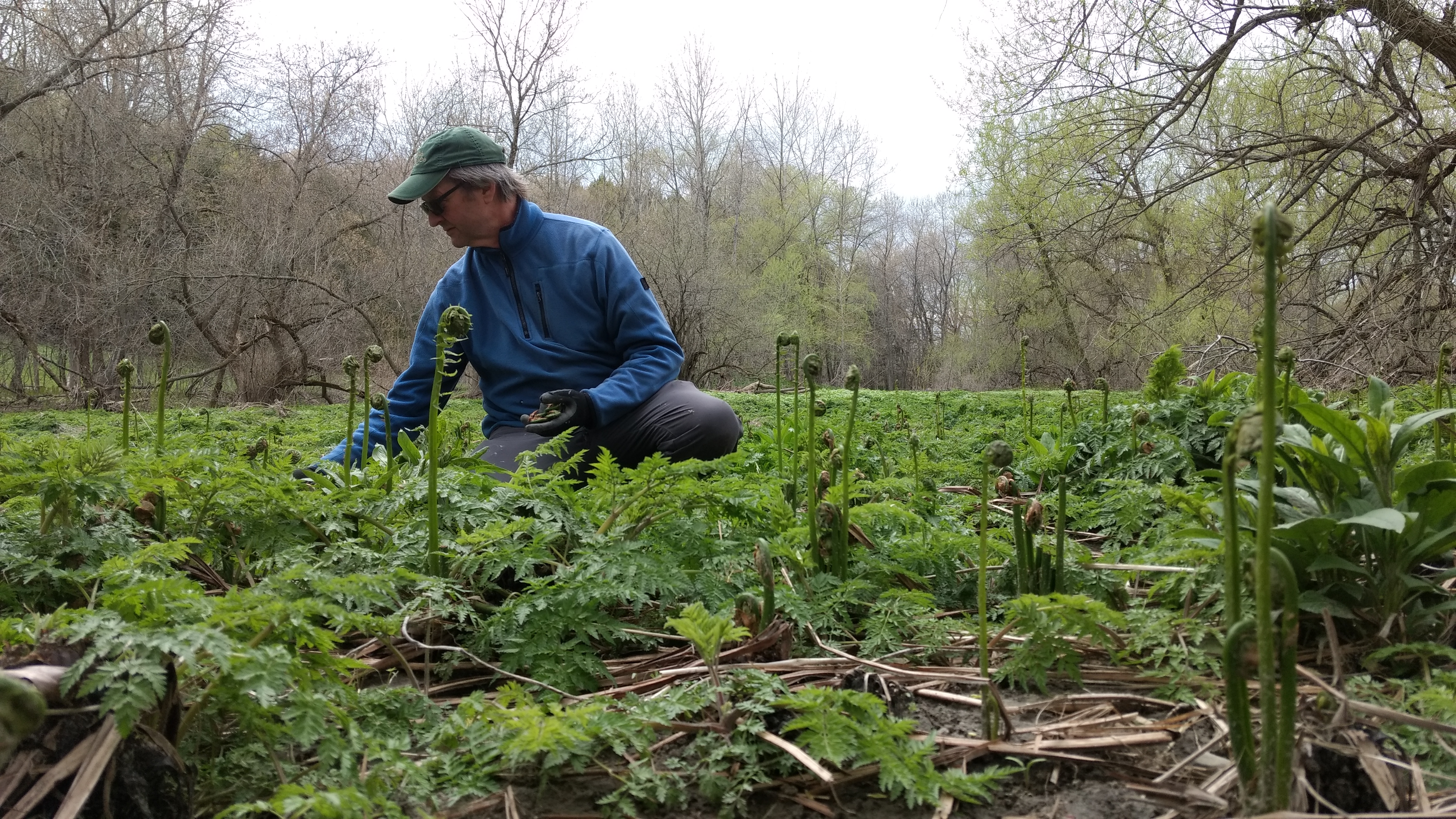
 erythrone/trout lily
erythrone/trout lily
Now, the early season stars like Trout lily, Dandelion, Spring Beauty and Linden have gone, as Stonecrop (live-forever), Daisy and Violet take their place. There is stinging nettle, garlic mustard, sheppard’s purse, wild chives and such.. as the buds appear, the edible flowers start to bloom and first marine greens pop.
It was a great morel season.
I couldn’t help but notice how many people were out there foraging and posting pictures of wild edibles this spring. It is clear that this is a trend that is only growing.
Which is great and NOT.
It’s natural that once awakened to the delights of the forest that passionate eaters and cooks want to get out there themselves. I remember my beginnings at L’Eau à la Bouche with Anne Desjardins where I met François the pioneer of foragers, how thrilling it was to discover these new ingredients. I was lucky to team up and build on his experience, taking the wild thing a step further than the chefs he'd worked with before in the Jardins Sauvages kitchen. But being leaders in largely uncharted territory meant that we had to figure a lot out on our own. Just that a certain plant is edible and best used a certain way is taken for granted now, while many years of research, tests and samples given away lie behind. Not to mention the miles walked and free labour on François' part going back 30 years. Today, it seems that every other menu resembles one of mine from 10 or 15 yrs ago, with game, wild greens & wild flavours everywhere, back when I was the only one with sweet clover or wild mushrooms in my desserts, ha. I knew we were onto something, but who knew it would ‘mushroom’ so.
For sure foraging is awesome in so many ways; it doesn’t get much more terroir, fresh and local than that. But the thing about foraging, is that it’s trickier than it appears! It is not as easy as walking through the woods and filling your basket, it is not 'free'. You need land, and knowledge, a due respect for nature and nuance, lots of time and patience, before actually putting in the hours and doing the work. Finding your spots, being there at the right time, getting down and dirty on your hands and knees with the mosquitoes. It takes more than a day or a season to learn the basics, plenty of books and time spent in the woods. Way more than a google search or utube video, say. People these days want to go too fast. It’s not that I want to discourage eager enthusiasts... But Please! I just wish everyone would be more mindful and cautious. It’s for the plants, the future and one's own sake, not only sustainablility and safety, for deliciousness too.
Foraging primer: Bottom line, Don’t touch unless you know what you’re doing..
Which means How, When and Where.
First of all, know that what you’re picking is indeed edible (there are many look alikes). Ensure that it’s a healthy population. It depends on the microclimate and age of plant population. You need to know the cycle of the plant/how hardy it is before knowing how much you can take. That’s why being in the same spots, seeing the impact of your harvest each year is so important.
Don’t rip out roots (in general). Prune.
If you pick, don’t let it show, as in you’re leaving way more than you take, little trace. Unless you are weeding your garden or in a site with an invasive plant you know well.
Be careful/don’t pick species that are slow to reproduce or endangered: Wild garlic, Wild ginger, Crinkleroot, Milkweed..
And some need to be mature enough, and then just trimmed - like sea asparagus (salicorne, samphire), otherwise you might kill the plant. This is an issue now when it is still several weeks too early to pick salicorne anywhere in Quebec. Yet, I see it on menus.
The ‘weeds’ you can worry less about, Go!: Lamb’s quarters, Nettle, Garlic Mustard, Sheppard’s purse, Purselane, Amaranthe..
And then in the kitchen, they need to be washed, and cooked properly! Some need to be cooked throughout: For instance: Fiddleheads, Milkweed, and most wild mushrooms. Wash well and boil 5min+. Less touchy veg like beach peas, goat's beard, and leafy greens like nettle might only require 1-2min. For mushrooms, a braise is better than a sauté, count 5-20min. Some greens are better raw, but most are better cooked even if slightly. All are super healthy ingredients, but can be toxic, you can’t just wing it. I’ve seen sprouts of toxic plants decorating plates in Montreal.
Don’t give wild plants a bad name by serving anything up because it sounds cool, as little do you know it might be of sketchy quality, often like those on the black market or picked without experience.. For example, dandelion is only good if picked young (before flower) in the morning; most greens like live-forever only in shady, humid conditions; garlic mustard is only yummy young/early season and same, bitter in dry conditions. Same with beech chickweed. Etc. Where, when and how was it picked/stored etc.. is key to whether it will be yummy and not give anyone a belly-ache.
With many wild plants and aromatics (herbs/spices), it’s a question of dosage.. As with nutmeg, basil or rosemary, all of which can kill you if you eat too much. The difference between delicious, medicinal and toxic is in the dose. Normally nature is well made, as in you won’t use anything potent in huge quantities - the difference between a vegetable and an herb, a stock or a sauce. For example, be careful with mélilot/sweet clover flower, sweet grass, conifers - less than .1%. . Oxalis (Lady’s sorrel), like kale and rhubarb leaves contains oxalic acid, which is hard on the kidneys. And so on.
(See more picking tips and photos/links below..)
Whether picking or not, Chefs using wild ingredients need to be responsible for their source or purchases! (See Black Market blurb below) And you can participate. There is a conference on the commerce of PFNL (wild edibles) and the development of guidelines, with chefs and journalists invited (June 14th in Quebec City), the first public meeting of the type, there will be more. It’s about developing the industry further, but in a structured and sustainable way. See below.
Rules and Regulations – they are coming, but it’s complicated
This explosion of amateur foragers and start-ups might be a plus for the economy but problematic for sustainability of the resource and market, quality and safety. Making some sort of regulation has become necessary. Which is what groups of people in the industry and levels of government are currently working on but it’s incredibly complex. Between the interests to develop the forest beyond lumber, putting people to work in the regions, sharing our heritage while balancing what is possible with respect to nature and the realities of the market, labour, what is doable and fair when it comes to enforcement... Quotas, permits?
It’s a big pain in the ass actually. We have no choice but to be implicated, because we care and have expertise to bring to the table, and obviously, it will affect us directly. Trust me, we would rather not have to spend so much time on all this debate and data for regulation because although we believe in it, I can humbly say it shouldn’t even apply to us. Because of all the careless people who ravage or innocently don’t know what they’re doing, we might be banned from picking and exploiting edibles we have plenty of on private property, picking sustainably in the same spots every year (for 30 yrs). Nonsense. No one even knew about most of these wild edibles until François put them on menus by introducing them to chefs.
Or like with ramps. We have a healthy population that we could easily sustainably put it on our menu from our back yard, but it’s illegal. If I chop up a few leaves as a soup garnish for 10 clients there is an inspector at my door. Meanwhile, chefs all over Montreal who do hundreds/thousands more covers have ramps on their menu, from where? No inspectors? So it should be illegal, but what difference does it make? Ideally, it should be legal but regulated.
Black Market Everyone likes a good price, be it at the market or from a picker coming to a chef’s door. This year (and last) at Marché Jean Talon, there was so much black market dumping for fiddleheads, that we had to sell at a loss to discourage them. Because these guys don’t have fridges or a legit business, pay no rent or taxes, no inspectors, zero traceability. Who knows where or how it was picked, stored.. They need to unload so sell at whatever cost, ie dump. Merchants buy and sell. Like with wild mushrooms too. So say this foraging guy decides to continue beyond a day or two, he needs to buy a fridge, register a business, have a clean locale that will be inspected, he will want a website and business cards, maybe an accountant etc. Soon enough he will charge more or bail. Which is what they all do, bail after crashing the market with questionable quality produce, even poisonous mushrooms. So that’s the future if things don’t change, a bunch of n’importe quoi.
Meanwhile, we have for years, sustainably and passionately brought wild edibles to the market (at the restaurant, to chefs and le grand public, in the cooking schools), offering tastings, given out cooking instructions, building the market, teaching. If people want to be able to buy wild edibles from a reputable source, the present scenario is not sustainable.
Marketing vs Truth Everyone has local, something wild or boreale on their menu. But often it’s Bullshit, a few spices and maple syrup while most comes from big suppliers, imported. The morels on the market in March (when every chef wants to put morels on their ‘spring’ menu) came from China. And often, the wild mushrooms and vegetables come from out west, Europe or China, the deer often from Australia; elderflower from an imported extract, sumac imported and very questionable in composition. Wild arugula out of a Costco box is imported monoculture, not the same species as our wild rocket. Just because it sounds wild and local doesn’t mean it is. It sucks to have to question the glossy menu local wild vibe at your hot restaurant. But I’m kind of tired of being the real thing seeing all the BS that doesn’t seem to matter. I’m done with being polite.
Its great that many people want to reconnect with nature, eat locally and explore new flavours. A richesse de notre terroir that naturally should be a part of our culture and traditions, as it largely was before everyone moved to the city and started destroying biodiversity. Now people are waking up to the treasures, but there is less to go around. I know there are many young people opening Boreale restaurants or bars, making gin and cocktail kits, etc with the best intentions, without realizing the issues surrounding the sourcing. Like no idea what 100kg of juniper berries or Labrador tea entails.
Hopefully, we can all move forward with wild edibles for everyone who cares!
Info about the Conference for PFNL guidelines, hosted by the ACPFNL https://www.acpfnl.ca/ Details here: file:///C:/Users/utilisateur/jardins%20sauvages/pfnl/Acpfnl/ACPFNL%20invitation%20AGA%20du%2016-05-2017.pdf To stay informed, the ACPFNL Facebook page: https://www.facebook.com/Acpfnl-Association-pour-la-commercialisation-des-PFNL-178644682180969/
Foraging primer Edible Manhatten http://www.ediblemanhattan.com/departments/d-i-y-departments/forage-or-harvest-a-spring-foraging-primer-for-the-new-forager/
Spring, ramps and fiddleheads http://soupnancy.squarespace.com/blog-journalessays/2015/5/5/officially-spring-2015.html
There are many photos with the plants identified in our albums on our Jardins Sauvages facebook page https://www.facebook.com/JardinsSauvages17/?ref=bookmarks too..
Summer wild edibles http://soupnancy.squarespace.com/blog-journalessays/2011/7/19/snapshots-july-2011-summer-wild-edibles.html
Our old videos:
Spring, trout lily https://www.youtube.com/watch?v=qUMfSfquRpU
Other early summer backyard treasures https://www.youtube.com/watch?v=7Alf1arm478
Wild chives and https://www.youtube.com/watch?v=1kL2ycqvu_Y&t=172smint riverside https://www.youtube.com/watch?v=7Alf1arm478
Stinging nettle https://www.youtube.com/watch?v=1kL2ycqvu_Y&t=172s
Disco Soupe Slow Food
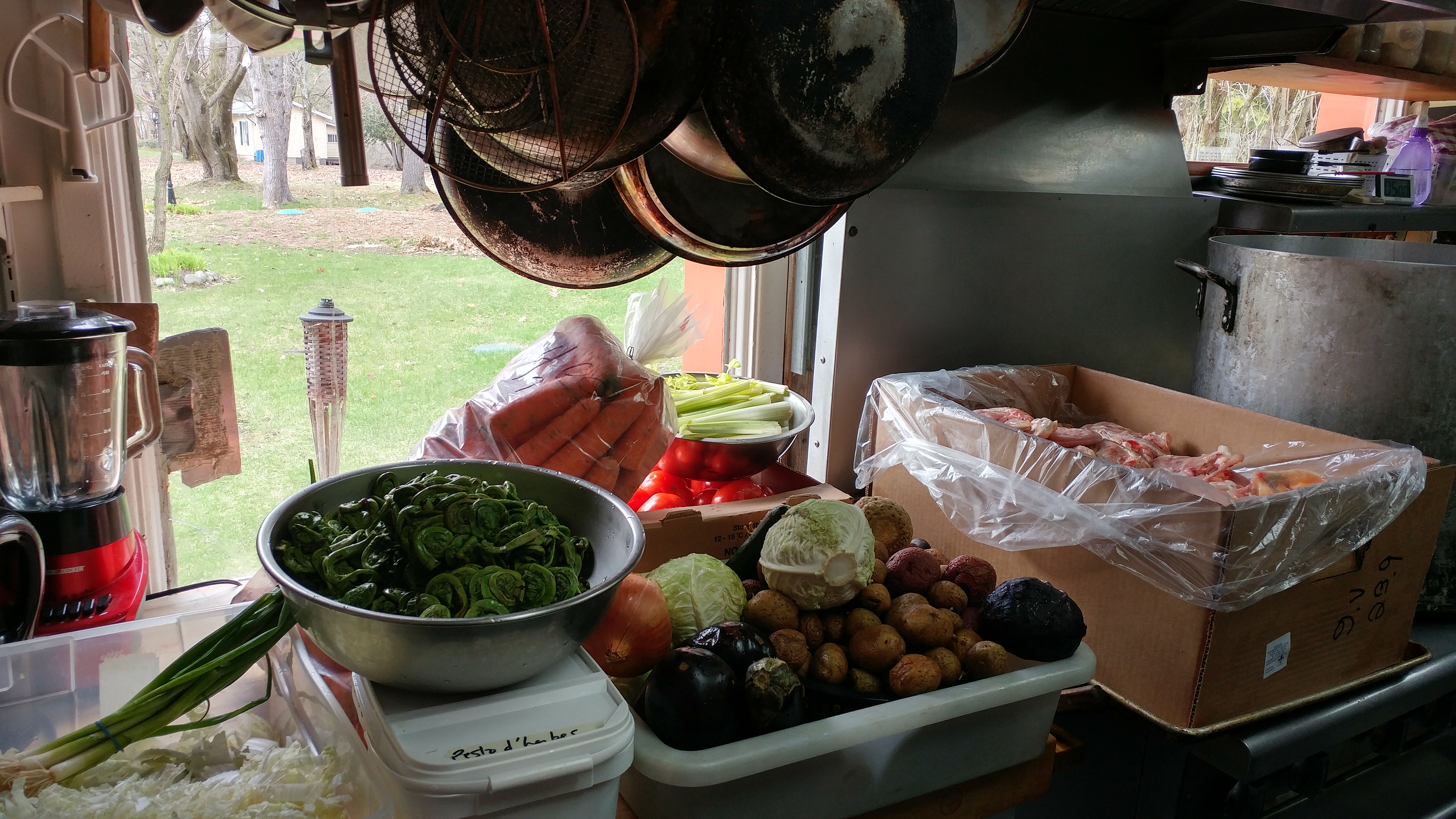 Part of our collect for soup; Legumes moches et carcasses
Part of our collect for soup; Legumes moches et carcassesEaster Egg-spiration
Spring is in the air! Here is some egg-spiration including ever relevant prior posts and a few egg recipes for Easter (and year-round..)
As with most people, I am always inspired at Easter especially because the seasons are changing and it’s our new year! These guys take the cake though with their easter egg tree..
But wow, looking back at my blog, I’m extra inspired by how inspired I was in 2007 or 2008. It all still holds true, but let’s just say, the wonder of eggs and a ‘God’ we don’t understand are now givens; I am presently more focused on just getting a ton of mundane tasks done - like my cooking, paperwork and cleaning, maple soda and hiring, planning for the season. The greens will be sprouting soon enough, weehoo..
For Easter, On Eggs and God I really like this post (from 2008), which I also find amusing since I am even more of a witch now, fascinated by plant intelligence for instance. Once in a while, it’s important to stop, think and feel, question or accept, taking stock and ‘lacher prise’. Often time alone in the kitchen provides that space, like snowshoeing or running say, conducive to figuring something out and finishing off feeling good. A moment of peace and clarity can go a long way. There can never be too many elephants in the room. Besides, my dad the minister comfortingly told me once since that I am effectively praying to God by doing my thing the best I can, by practicing my craft and expressing myself in tune with nature, loving and doing and sharing, while being honest and true. My kind of religion. Scroll down to my Egg Epiphany. http://soupnancy.squarespace.com/blog-journalessays/2008/3/23/for-easter-eggs-and-god.html
My Easter Egg A quick ode to the egg and all its properties, from 2007. Kind of boring as in ‘duh’, but fact: eggs are truly amazing. How can you not find the phenomenon that is meringue extraordinary?! http://soupnancy.squarespace.com/blog-journalessays/2007/4/6/my-easter-egg.html
My Easter soup (from made with lamb lungs, a fun exercise in tribute to my producers and Greek tradition but not necessarily one to repeat. http://soupnancy.squarespace.com/blog-journalessays/2011/4/18/greek-easter-soup.html
These following recipes are more of a sure bet, like my eggs en cocotte (baked) with wild mushrooms and greens below.
First of all, a basic egg cooking guide is a good idea to share with your kids or to revisit if you’ve forgotten to cook eggs. Everyone should know how to cook eggs. http://firstwefeast.com/eat/complete-guide-to-cooking-eggs-at-home/ This overview covers basic egg knowledge; I just don’t agree with frying an egg in oil at high temp, but to each his own.. And for a hard-boiled egg, I stand by the method of putting them in cold water, bringing to boiling temperature, removing from heat and covering for 10min. Chill in running water while cracking the shells a bit and peel. When cooking in the pan, gentle/medium heat and butter, not oil. And I couldn't be bothered with the 62C degree egg. I prefer more texture, but mainly, why spend hours cooking an egg in a circulator, when 5 or 10 minutes with an old-fashioned technique works just fine.
An Italian Easter Ricotta pie https://www.theguardian.com/lifeandstyle/2017/apr/04/spinach-herb-and-ricotta-pie-recipe-rachel-roddy-torta-pasqualina
Egg toast Mumbai sytle https://mobile.nytimes.com/2017/04/06/magazine/egg-cheese-and-toast-mumbai-style.html
Pound cake An easy recipe to remember (approximately equal parts by weight of butter, sugar, eggs, flour), and a snap to make, it’s just plain good stuff. I had forgotten about this old classic, more often making a current lightened version using less eggs and butter, adding milk/yogurt and baking powder, vegetable oil for a fine cake or ‘quickbread’ (like banana bread), if not going all out to make a fancy dessert. I rediscovered pound cake this winter when my girlfriend was preoccupied with ensuring her athlete-daughter had enough energy for her competitions; pound cake was important filler. It was hanging around, we ate it. And then, I came back home to make it regularly. Bonus is that it keeps well on the counter for over a week, perfect with coffee or breakfast, or for a snack. Dress it up with coulis, fruit and whipped cream, caramel or chocolate it can be a swoon worthy dessert. While at JS, I would incorporate wild flavours such as mushroom powder or sumac, long pepper or sweet clover flower and maple sugar etc, this lemon poppyseed version at home is tough to beat. See recipe below.
Baked eggs with wild mushrooms and greens
Chef Nancy Hinton, Les Jardins Sauvages
4 portions
200g wild mushrooms (4c)
*(or 150g JS sousvide, cooked, frozen wild mushroom mix)
30ml (2 Tbsp) olive oil
15ml (1 Tbsp) butter
1 small onion, minced (1c)
5ml (1 tsp) minced garlic
45ml (3Tbsp) white wine
Pinch tarragon
125ml (1/2c) heavy cream
150g Blanched/Precooked greens (lambs’ quarters, wild mustard leaf, spinach fiddleheads, asparagus), chopped (2c)
4 eggs
drops to taste hot sauce or chilli flakes
drops worchestershire
to taste salt, pepper
100g grated cheddar cheese
option chopped cooked bacon
to taste maple syrup
Method:
Sauté mushrooms in a hot pan with oil. As soon as caramelisation starts, lower the heat a bit. Add onions and butter and cook over medium heat for a few minutes, add the garlic and lower the heat and cook 5-10 minutes more until the mushrooms are cooked through and tender, the onions translucent. You might want to add a squirt of water to finish the cooking (so it doesn’t dry out or fry). Season to taste with salt, pepper, worchestershire, herbs.
Deglaze with white wine and add cream. Remove from heat.
Add cooked greens, and make nests for the eggs.
Or divide mushroom mixture and greens into greased ramekins.
Crack the eggs into the nests. (You might want to break the eggs into a bowl first to make sure there are no shells).
Season again or add bacon, and a spoonful of pansauce or cream on top of the egg. Top with cheese.
Put in a hot 350F oven and cook for 10-20min until desired doneness.
*When it comes to small ramekins, it is often recommended to place in a pan of hot water which makes for a gentler heat but it takes a lot longer (like 30min) so your choice, after 10 minutes, you need to be checking.
*Serve with hot sauce and maple syrup or a tomato salsa. And good toast.
Œufs en cocotte aux champignons sauvages et légumes verts
Chef Nancy Hinton, Les Jardins Sauvages
4 portions
200g champignons sauvages (4t)
*(ou 150g Mélange Forestier JS blanchies congelées sous-vide hors saison)
30 (2 cu.à soupe) huile d’olive
15ml (1 cu.à soupe) beurre
1 petit oignon émincé (ou 1t)
5ml (1 cu.à the) d’ail émincé
45ml vin blanc
pincé estragon
125ml crème 35%
150g Légumes vert blanchis (chou gras, épinards de mer, feuilles de moutarde, têtes de violon ou asperges etc) et coupé grossièrement (2t)
4 oeufs
gouttes huile de piments/sauce au piments ou pincé piment broyé
gouttes worchestershire
au goût sel, poivre
100g fromage cheddar râpé
option bacon cuit et haché
au gout sirop d’érable
Méthode:
Faire poêler champignons dans l’huile à feu vif. Quand la coloration commence, baisser le feu et ajouter le beurre, les oignons et continuer la cuisson plus lente pendant 5 à 10 minutes de plus, ajoutant l’ail à la fin, jusqu’à temps que les champignons sont cuits au centre, tendre et encore juteux et l’oignon translucide. Rajouter un peu d’eau si c’est trop sec pour terminer la cuisson. Assaisonner les champignons à votre gout (sel, poivre, worchestershire, herbes..)
Déglacer avec le vin blanc, et réduire. Ajouter la crème et enlever du feu.
Garnir de légumes verts et faire quatre trous (nids) et placer les œufs.
Ou séparer les champignons et les légumes dans 4 cocottes individuelles beurrées et placer les œufs au centre.
Assaisonner et garnir de bacon si vous désirez.. Ajouter une cuillère de sauce/crème par-dessus l’œuf. Garnir de cheddar râpé.
Enfourner à 350F pour 10-20min jusqu’à la cuisson désiré.
Avec des ramekins individuels, on peut les mettre dans une plaque avec de l’eau chaude pour une cuisson plus douce (et plus lente). Peu importe, verifier la cuisson après 10min.
Servir avec un filet de sirop d’érable et sauce piquante.
Une salsa de tomate et du bon pain accompagne bien aussi.
Lemon-Poppyseed Poundcake
*I don’t remember where I got this particular recipe which uses cake flour, baking powder and an off kilter ratio with more butter, but I like it.
1 loaf (standard 9x5)
270g butter
1/2c each (230g total) brown sugar, white sugar
5ml (1tsp) vanilla extract
15ml (1 Tbsp) lemon zest
4 large eggs
2c (230g) cake flour
5ml (1tsp) baking powder
30ml (2Tbsp) poppy seeds
Method:
Have all ingredients at room temperature first of all.
Cream together the butter and sugars, lemon zest and vanilla (or whatever flavours you like) until light and fluffy.
Add in eggs one at a time, whipping well after each.
Combine dry ingredients and mix into butter-sugar-egg mixture, gently incorporating until homogeneous.
Bake at 350F in a greased/parchment lined loaf pan for 50min-1hr until a knife comes out clean.


